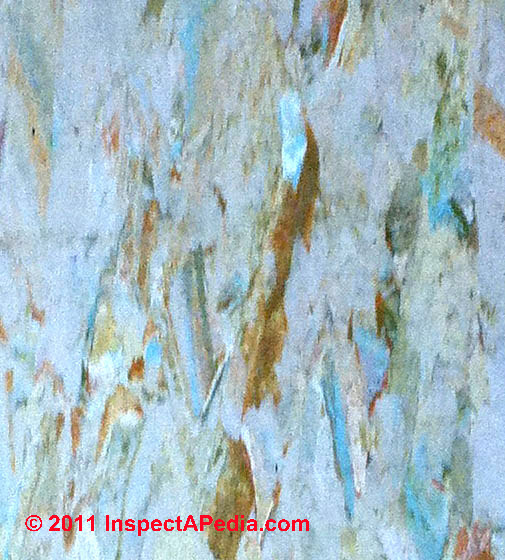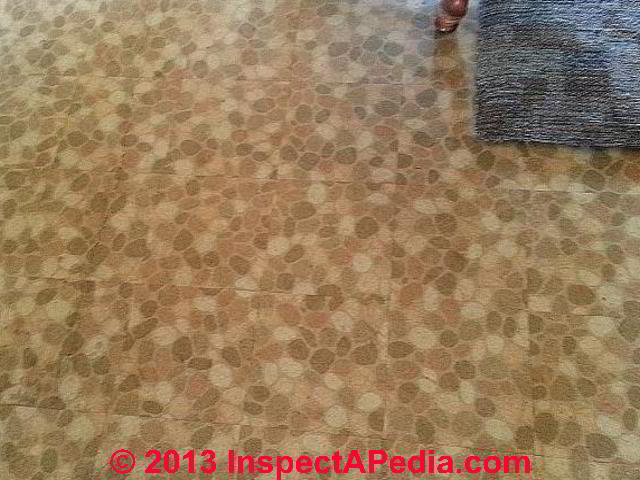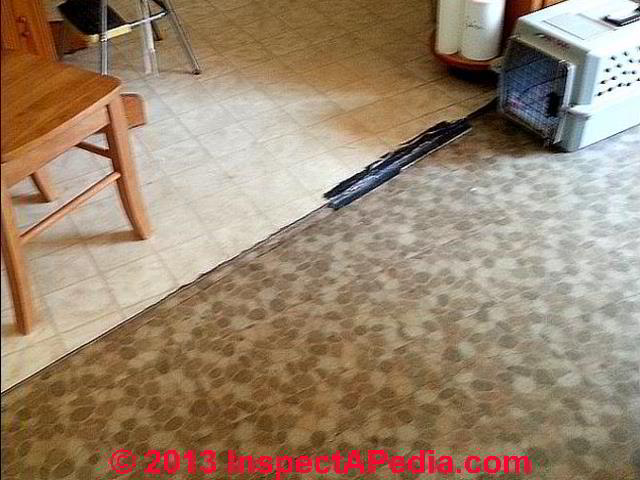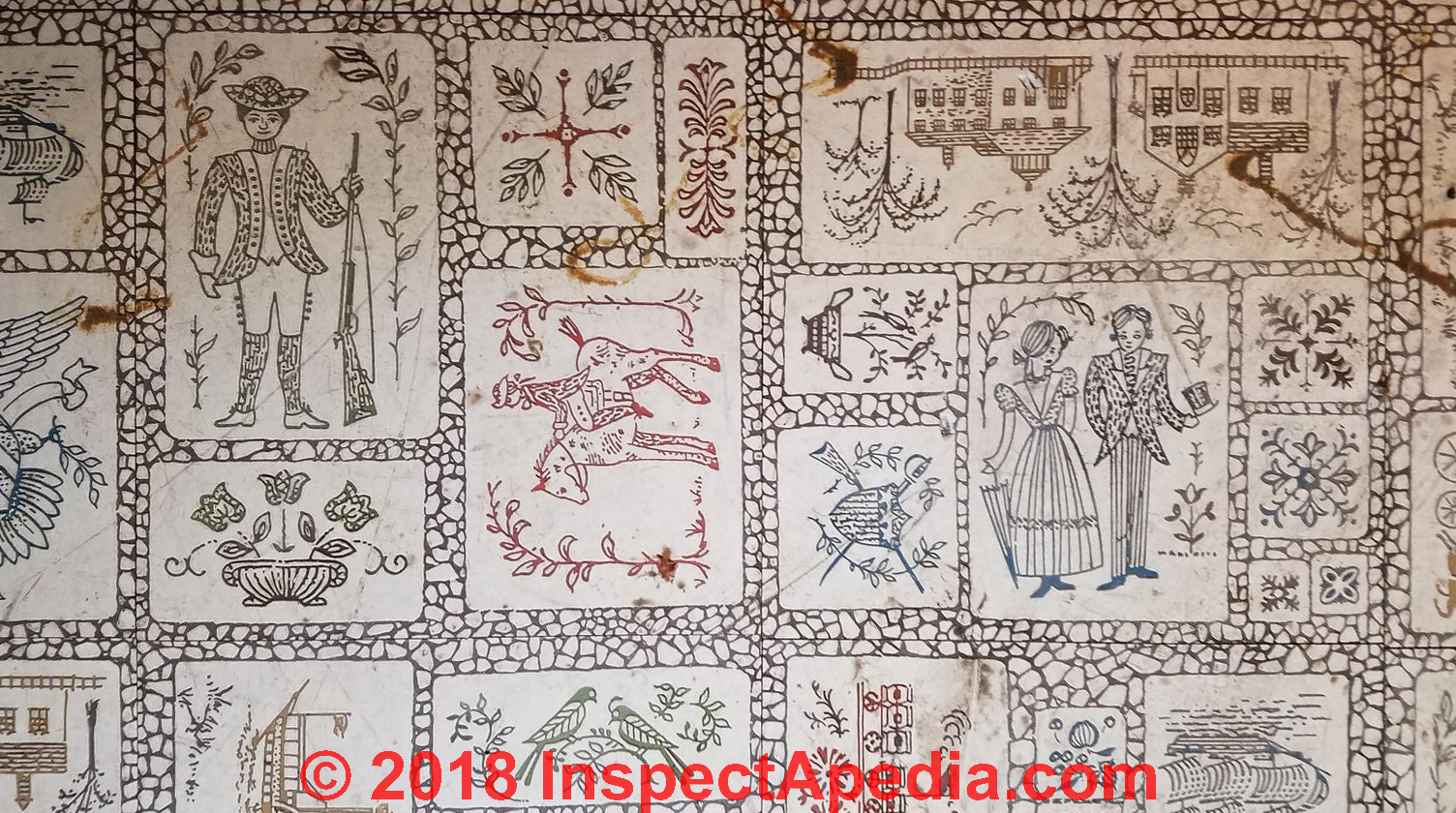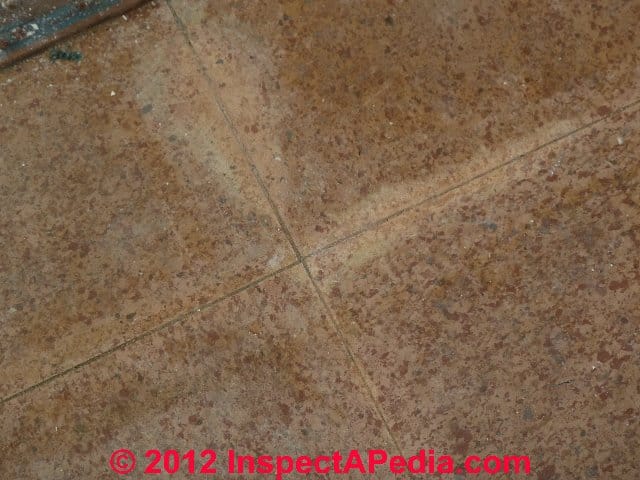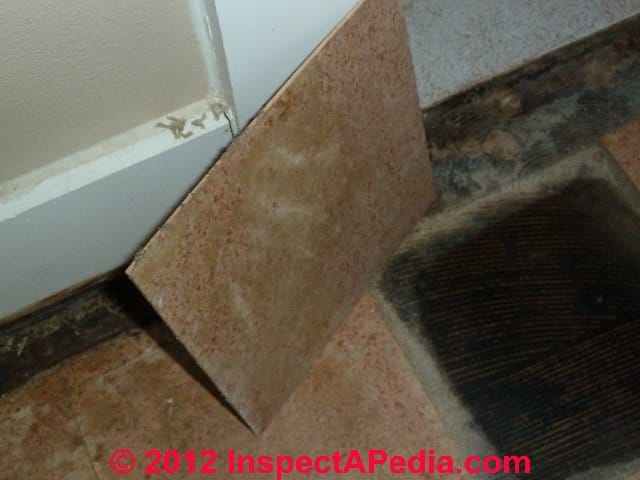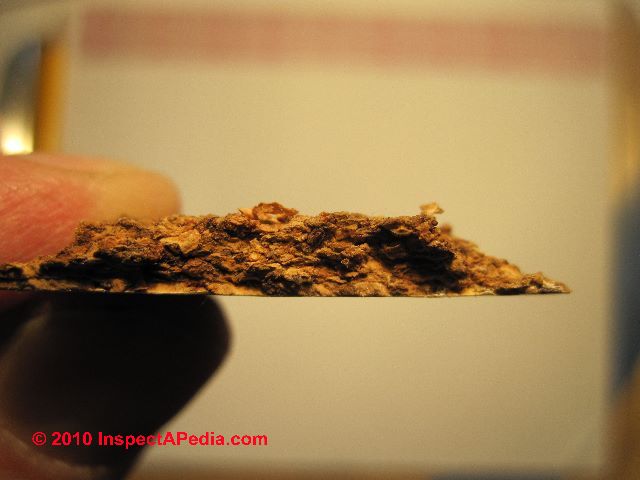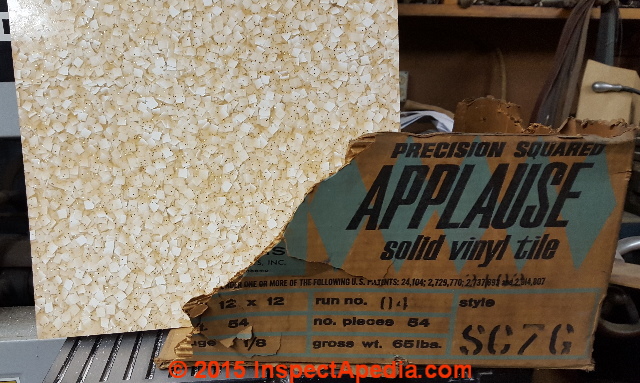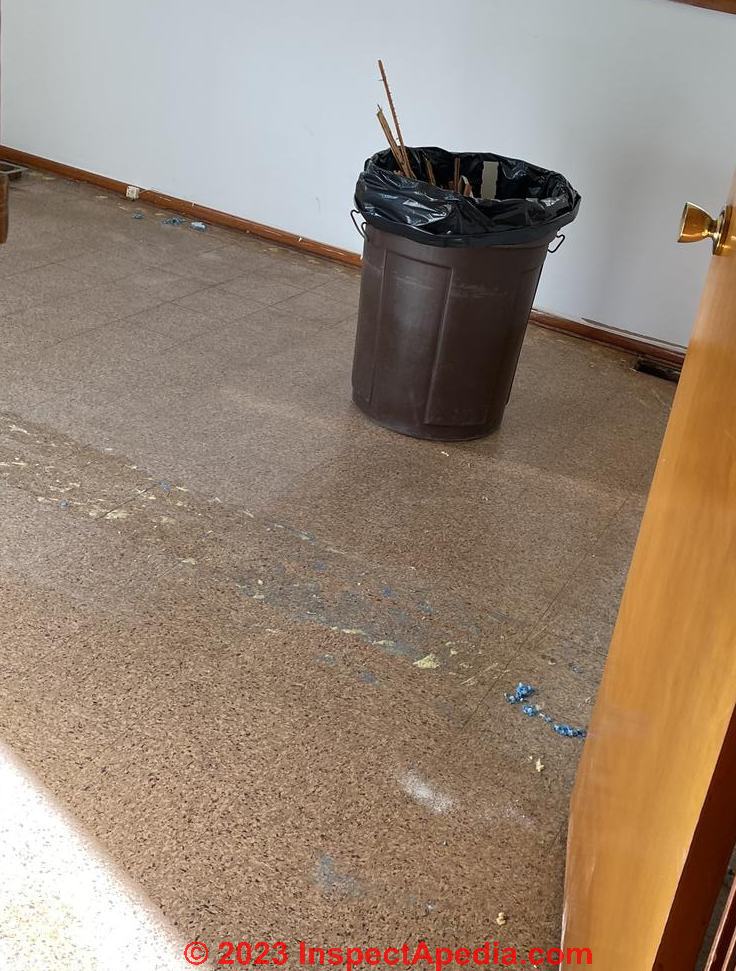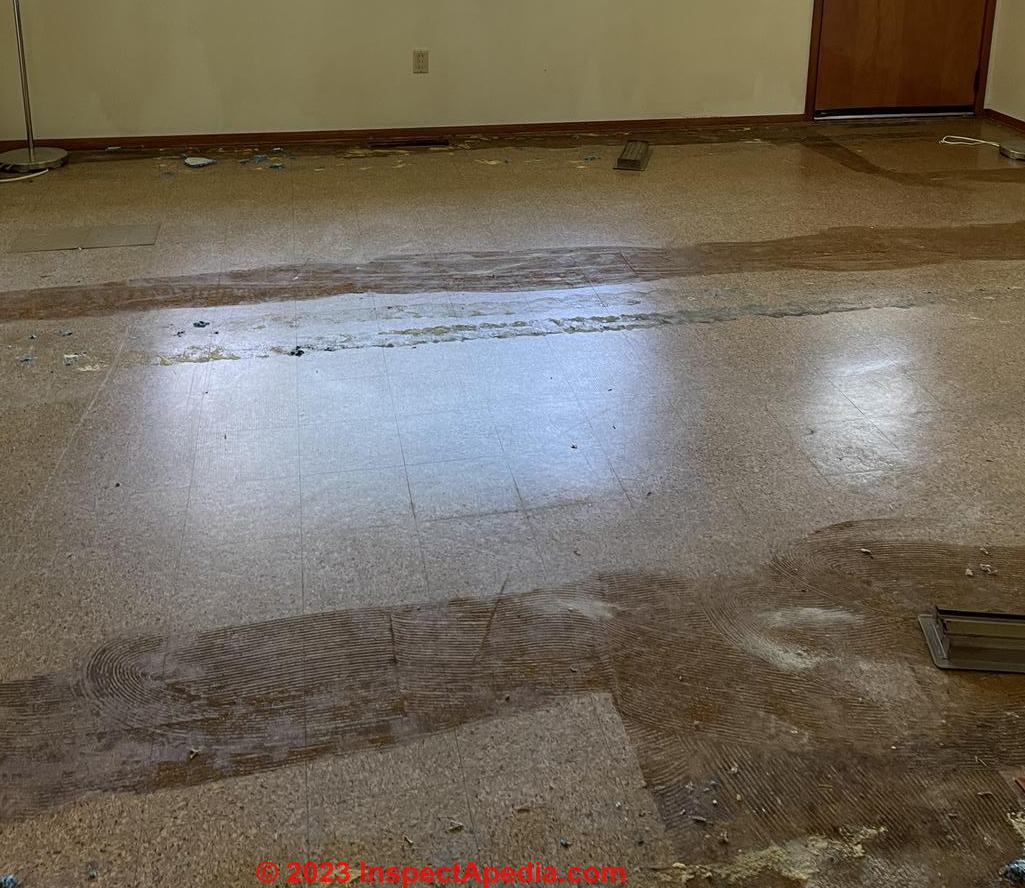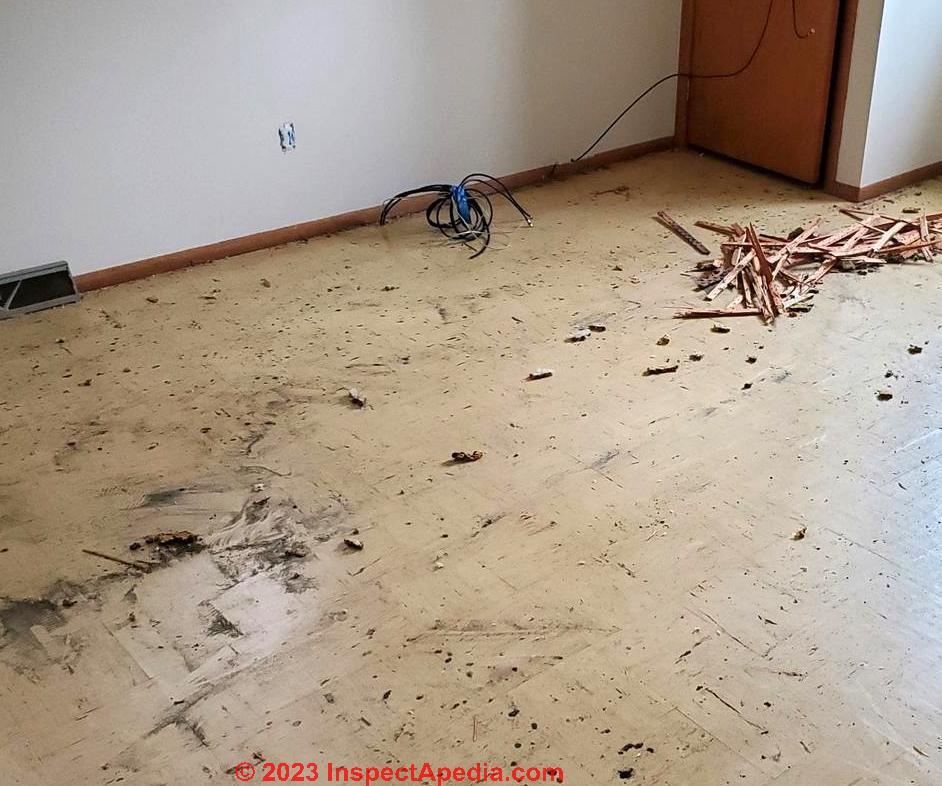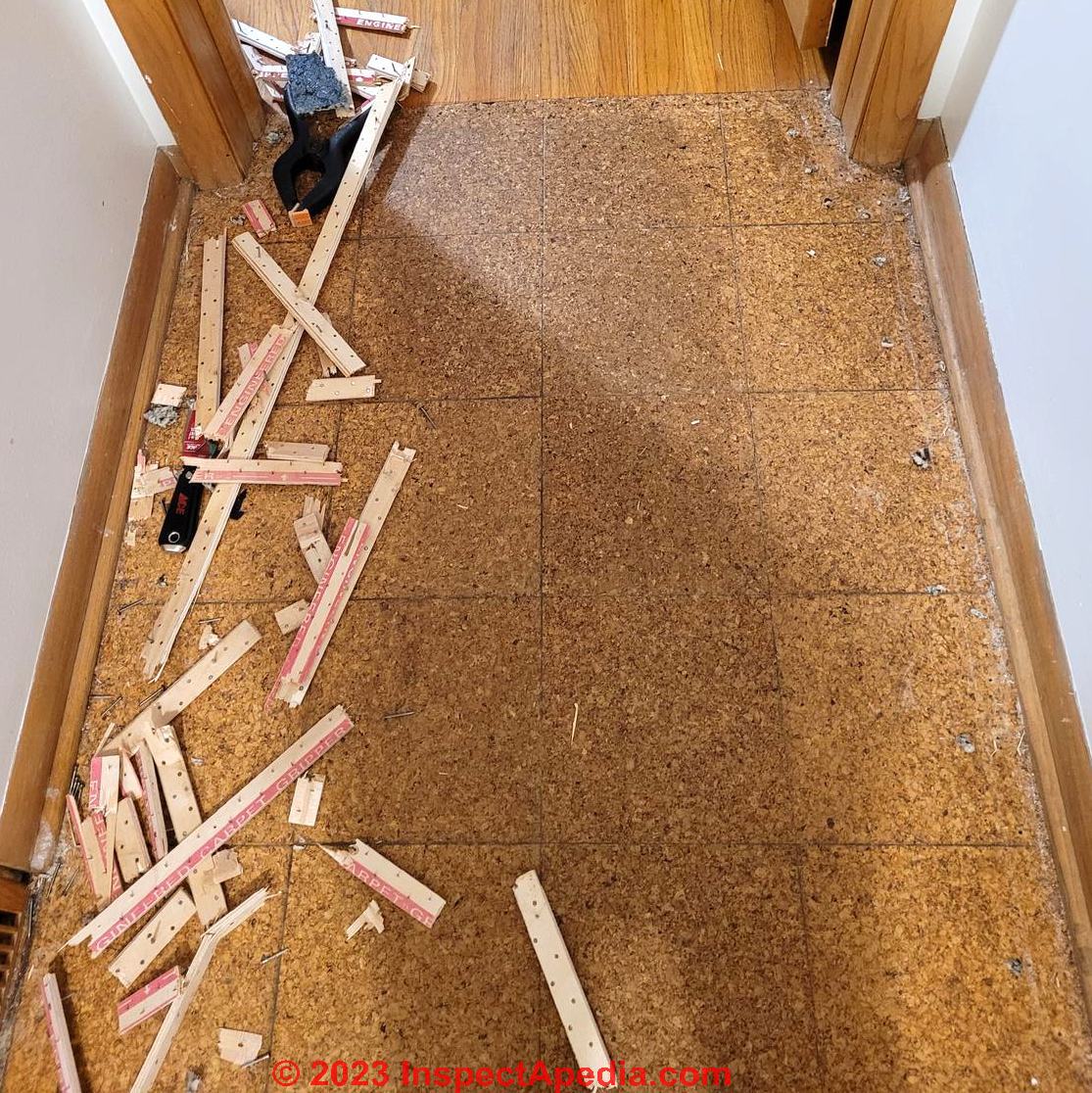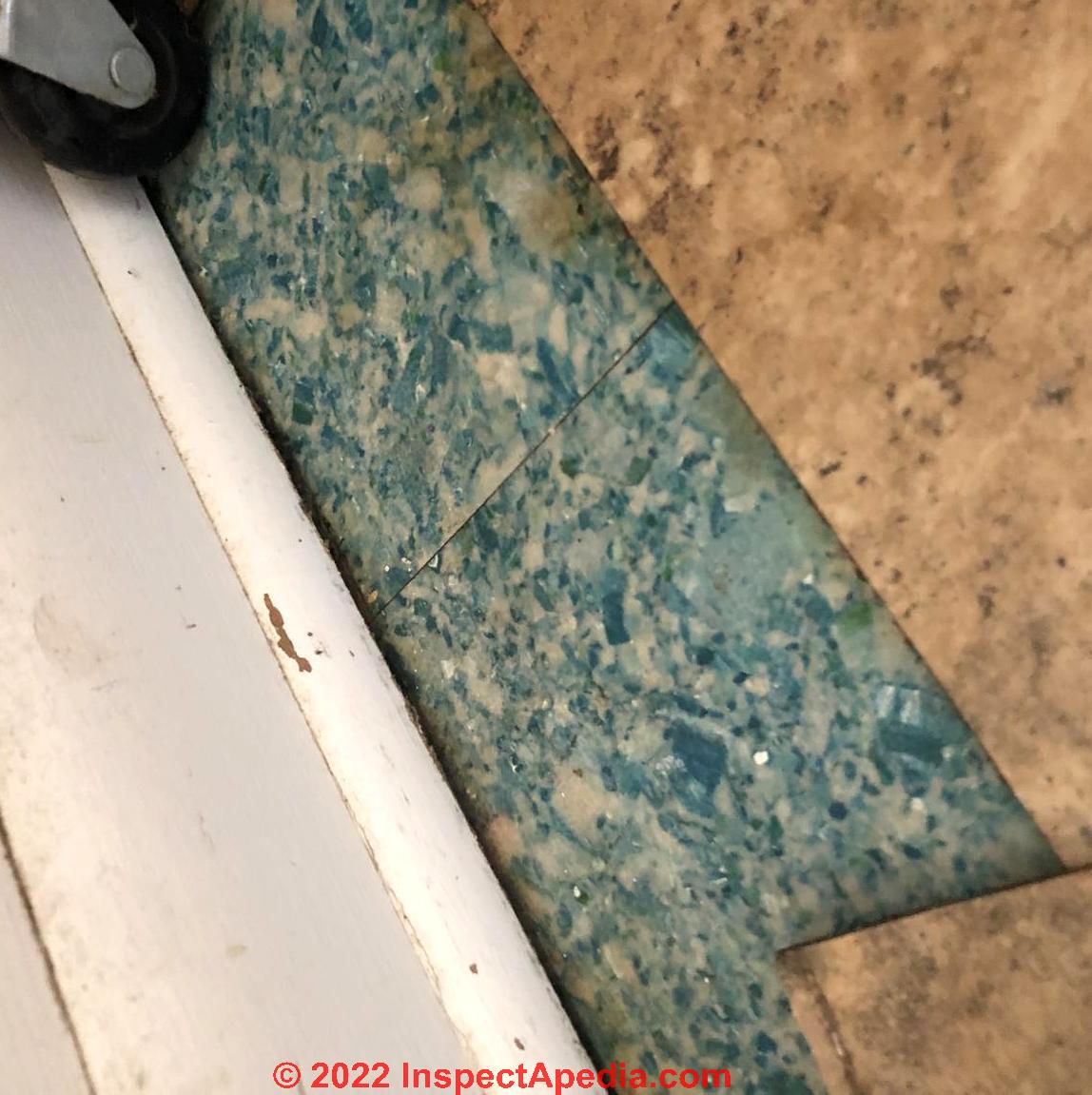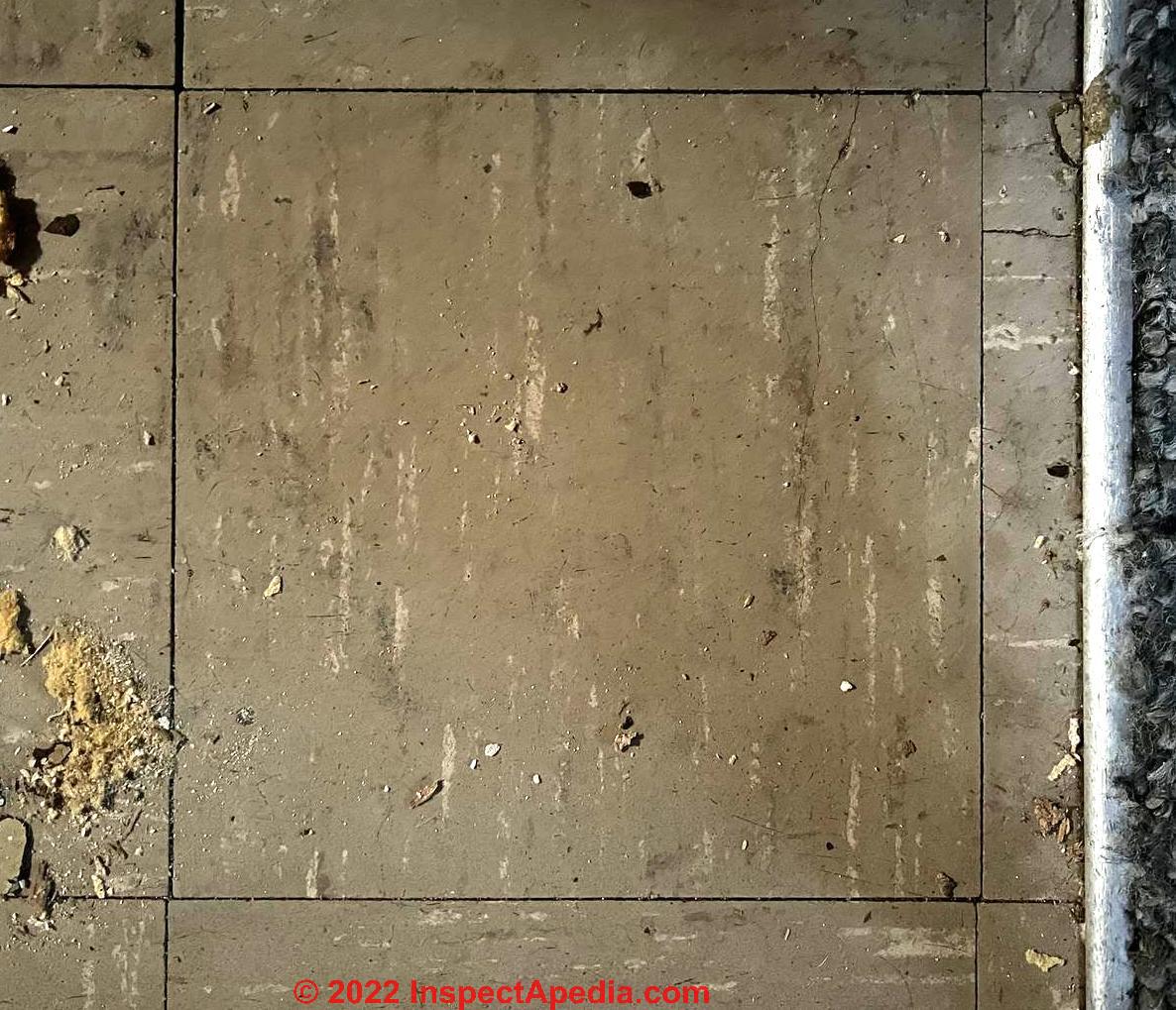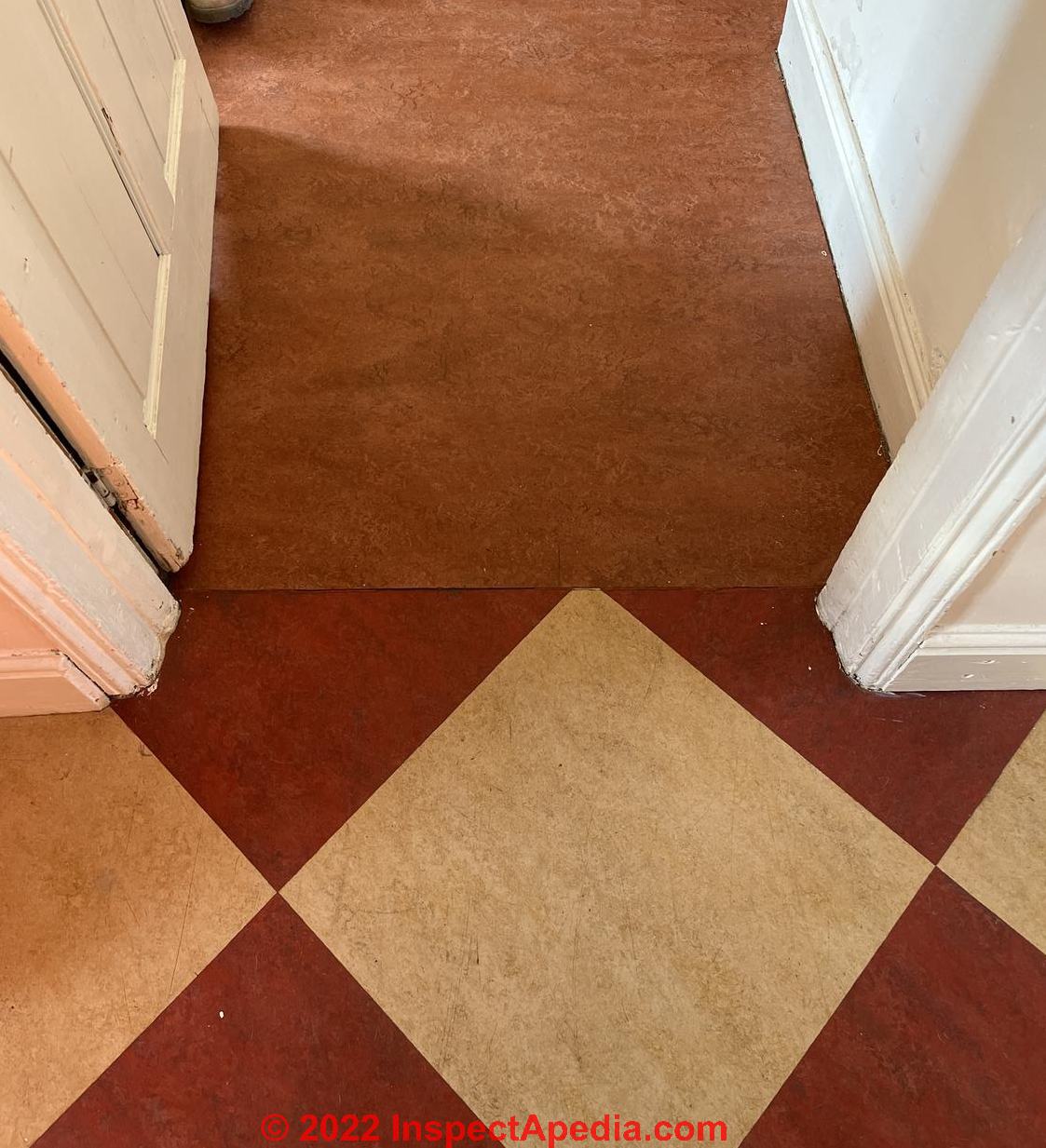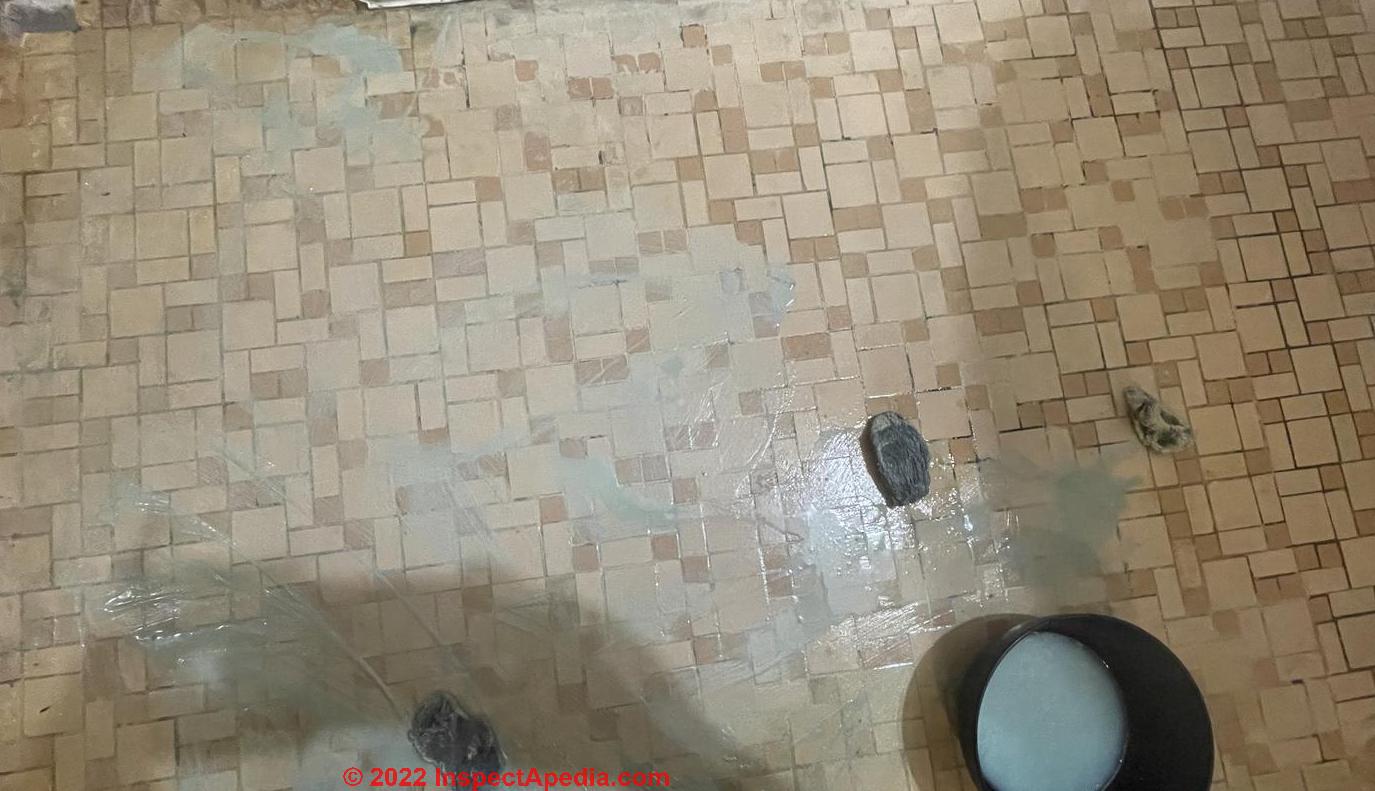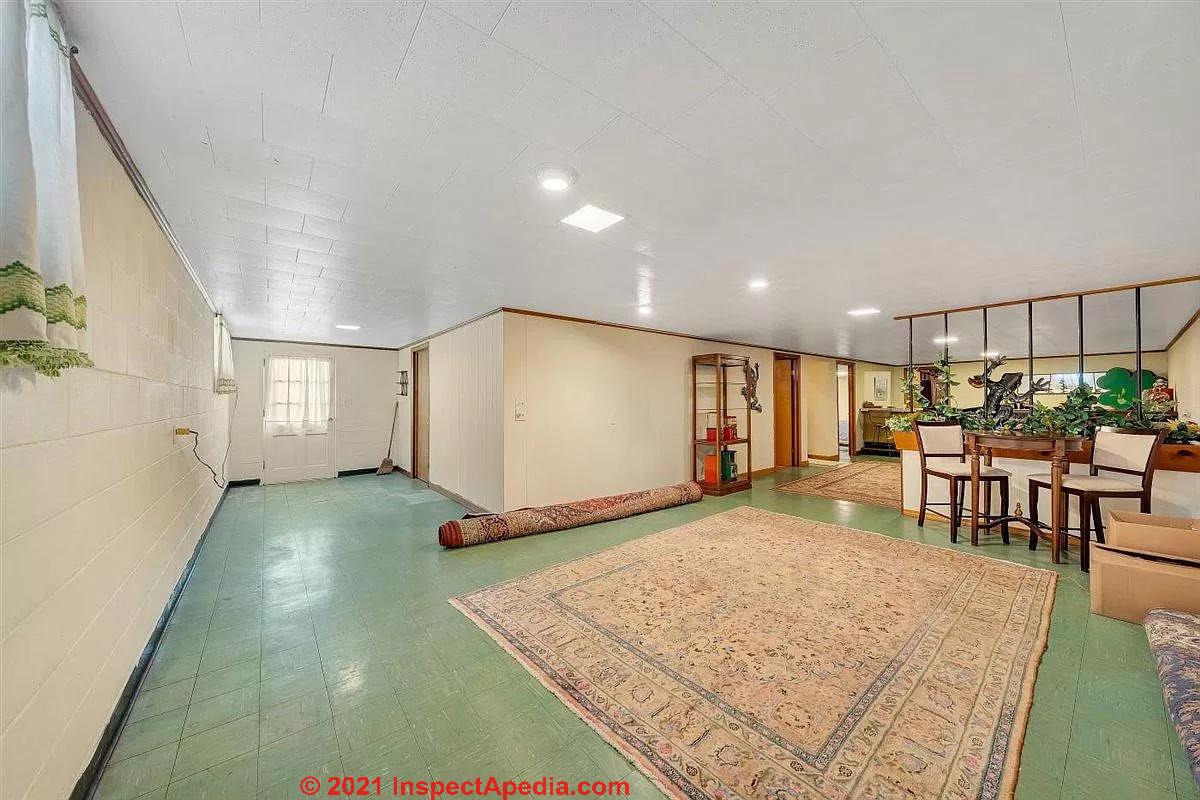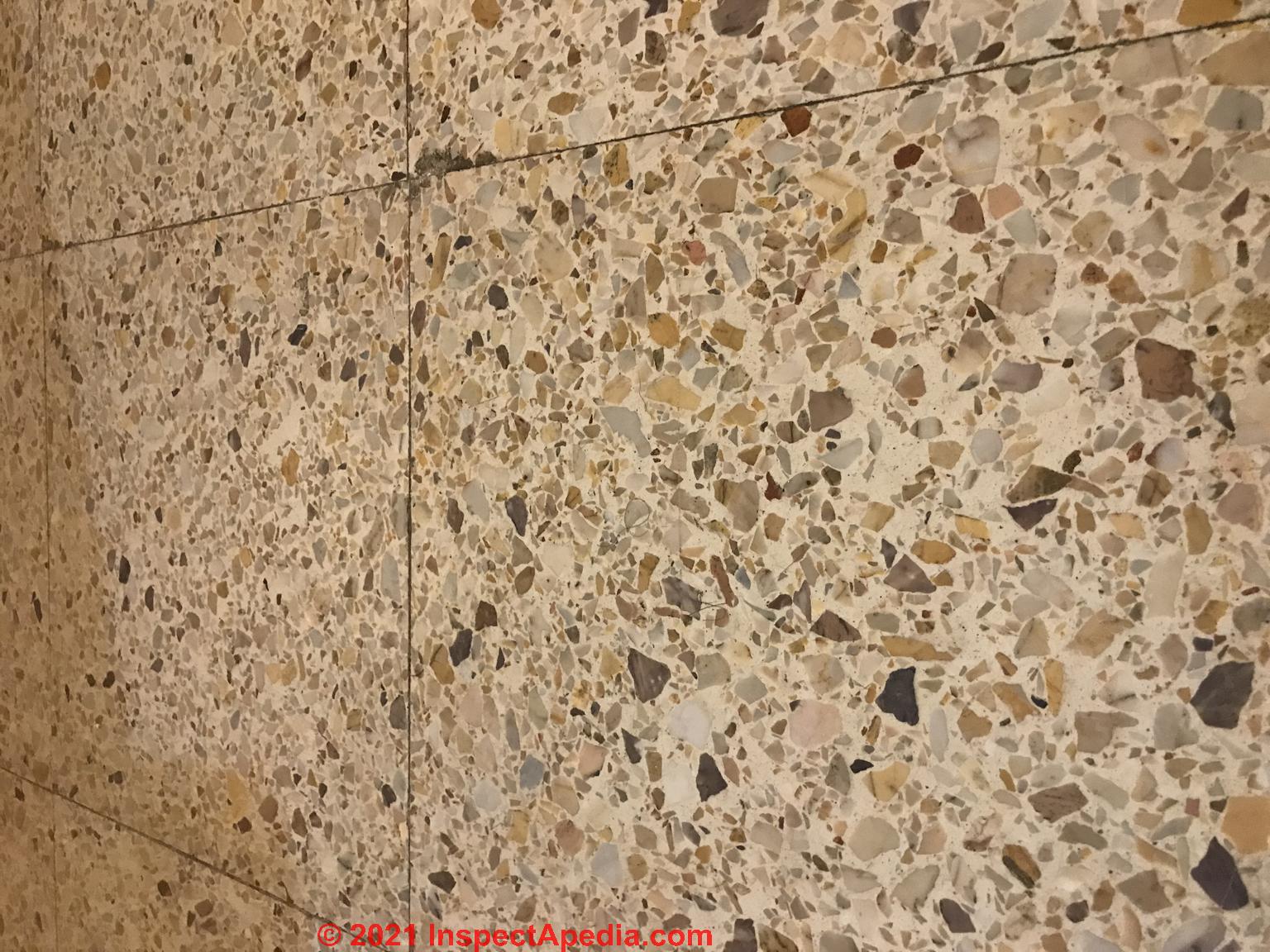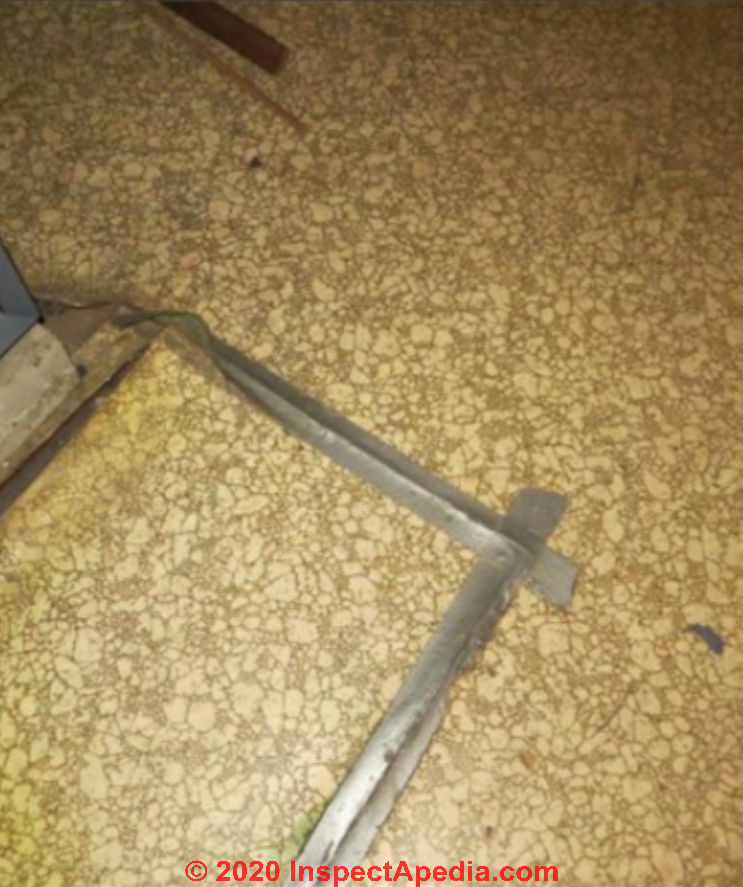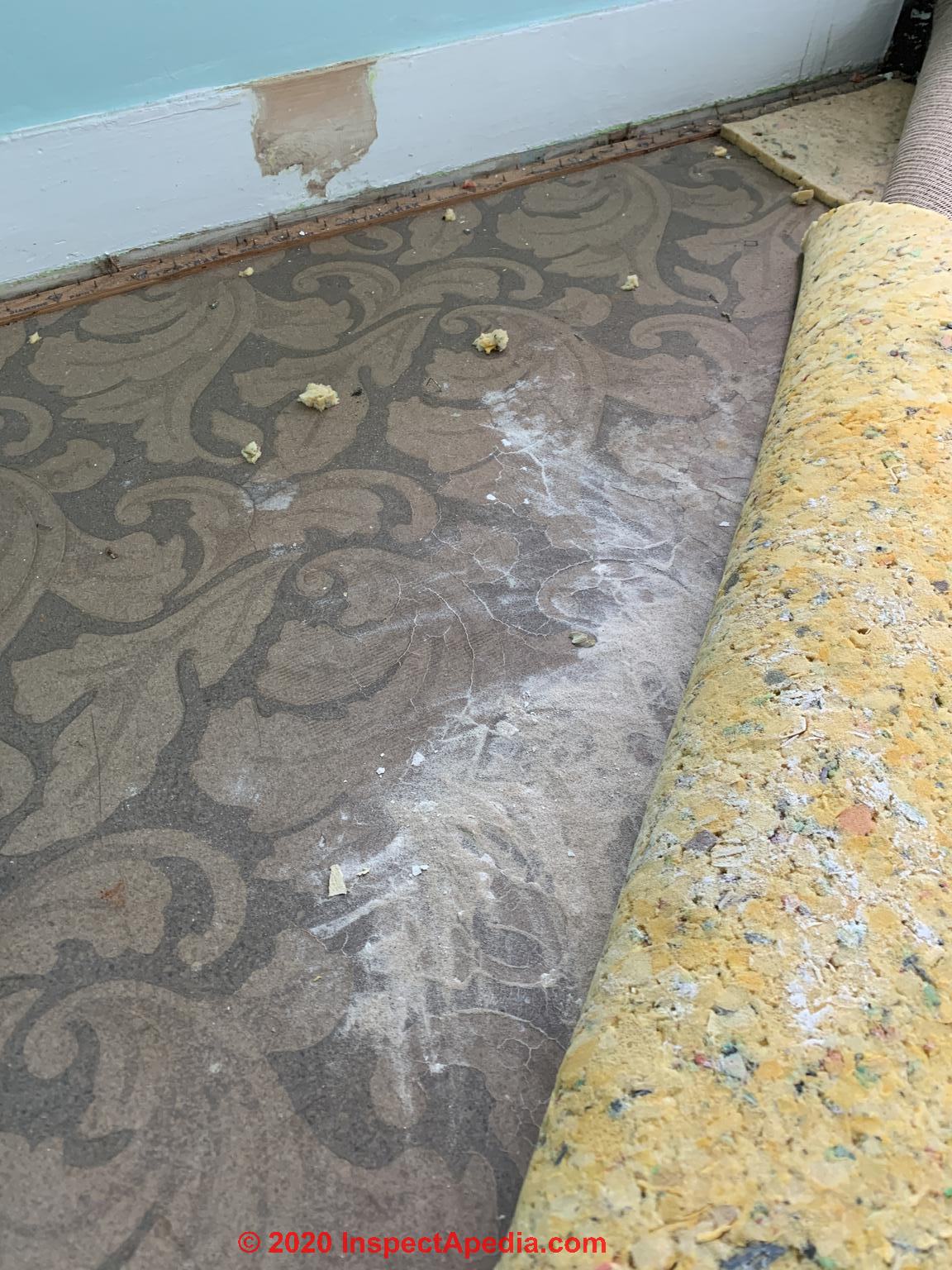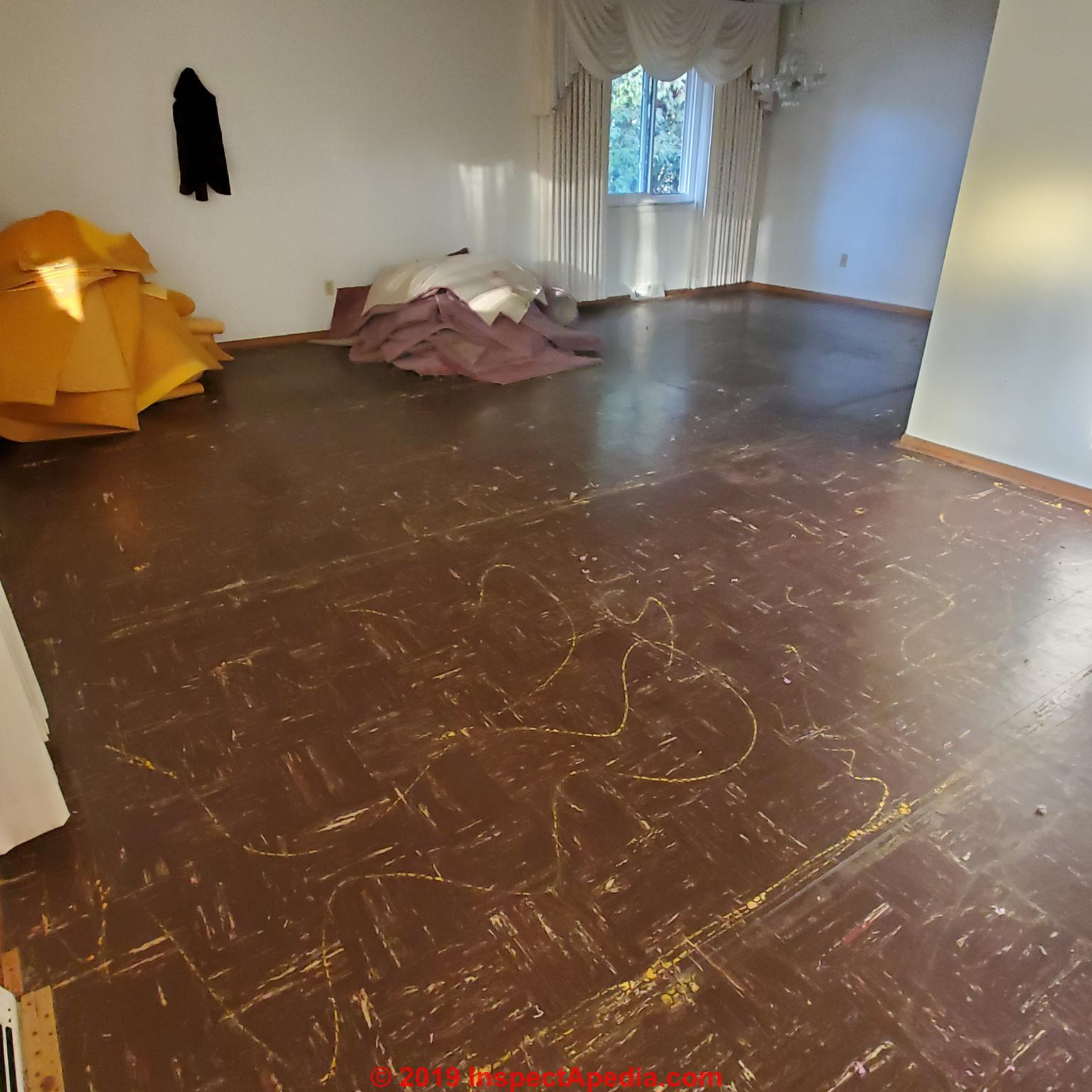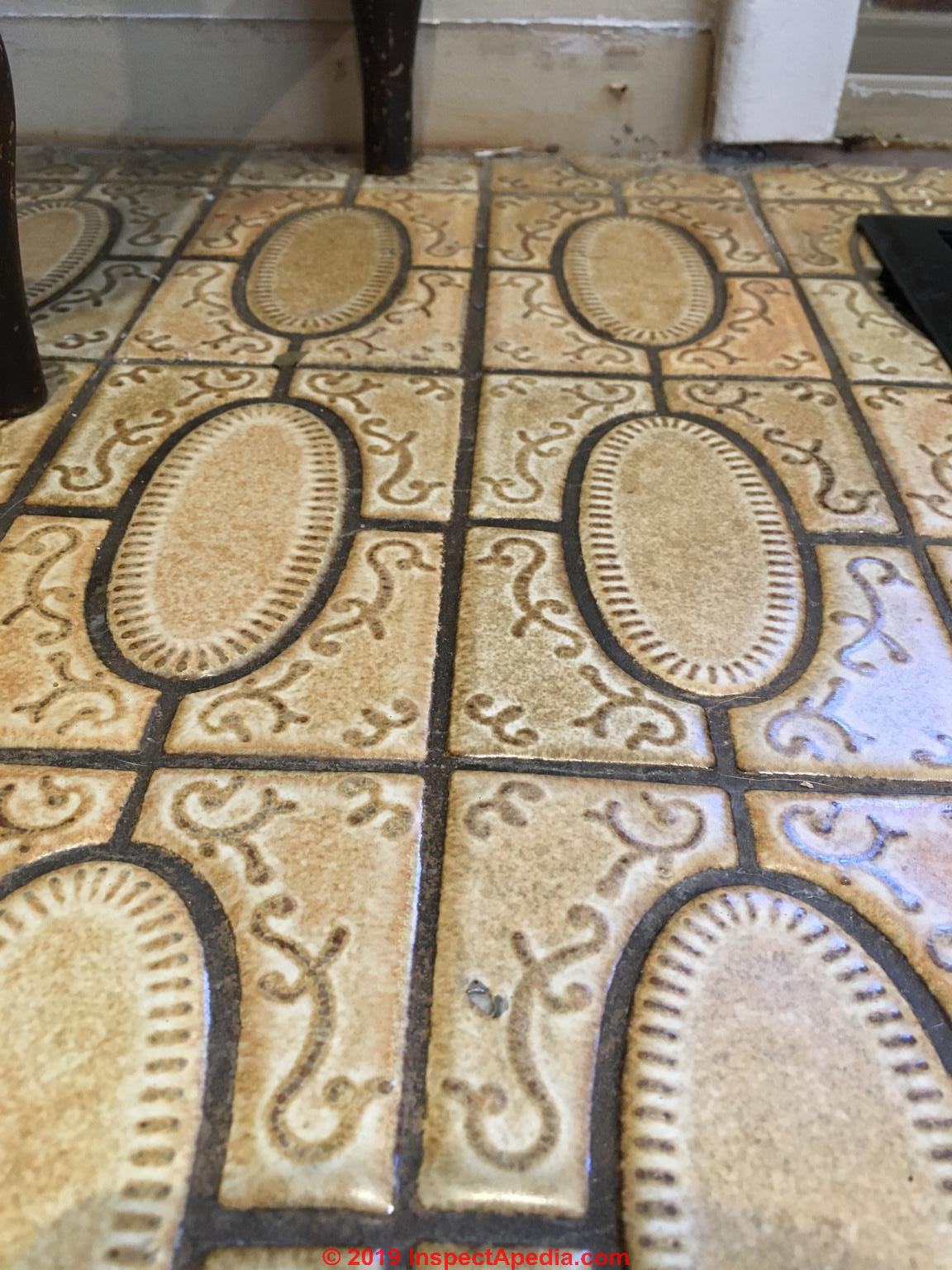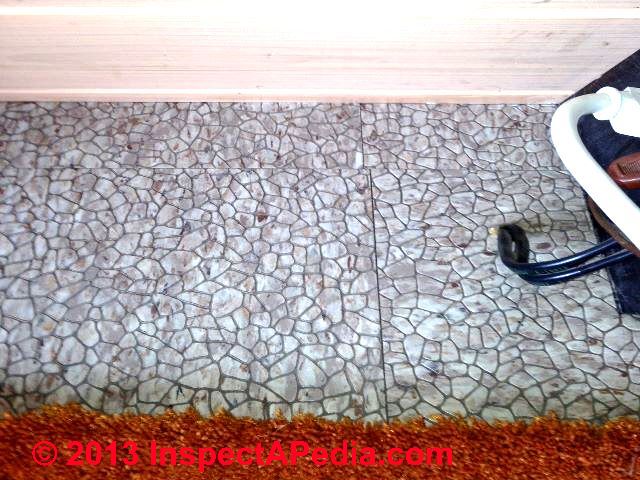 1960's Floor Tiles That May Contain Asbestos
1960's Floor Tiles That May Contain Asbestos
Photo Gallery of 1960's Era Flooring ID Requests
- POST a QUESTION or COMMENT about how to identify asbestos-containing flooring materials and what to do when asbestos-containing floor tiles or sheet flooring are found in a building.
Photo ID guide to 1960's Asbestos-Containing floor tiles.
This article provides flooring identification requests and representative photographs of 1960's floor tiles to help identify flooring that contains asbestos.
This article series includes a photo-gallery of pictures of floor coverings submitted for identification along with comments on findings, recommendations, & asbestos content. Readers can use our page bottom COMMENT BOX to submit photos of flooring to get help in identifying floor tiles or sheet flooring that might contain asbestos.
Asbestos is safe and legal to remain in homes or public buildings as long as the asbestos materials are in good condition and the asbestos can not be released into the air.
InspectAPedia tolerates no conflicts of interest. We have no relationship with advertisers, products, or services discussed at this website.
- Daniel Friedman, Publisher/Editor/Author - See WHO ARE WE?
1960's Floor Tile or Sheet Flooring Identification Requests
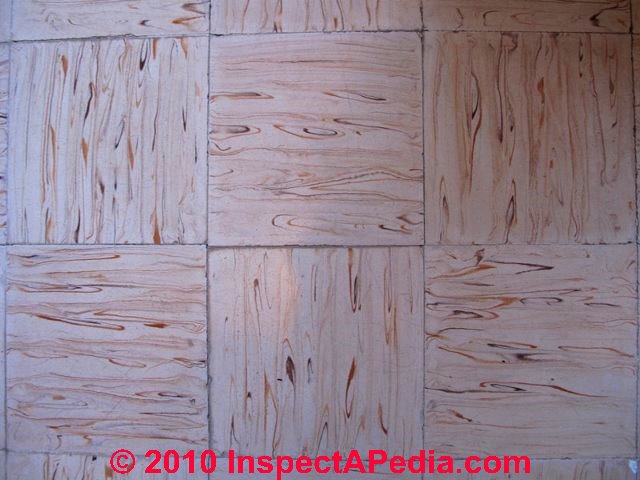 This article contains flooring identification requests for floor tiles or sheet flooring believed to date from the 1960's.
This article contains flooring identification requests for floor tiles or sheet flooring believed to date from the 1960's.
For a 1960's vintage asbestos-containing floor tile photo guide,
please also
see 1960-1969 ARMSTRONG EXCELON FLOOR TILE GUIDE: VINYL PLASTIC ASBESTOS, 9" x 9" & beginning in 1960 available in 12" x 12" size
or see our complete list of flooring identification photo guides
at FLOOR TILE / SHEET FLOORING PHOTO GUIDES
Question on reducing asbestos floor tile health risks in a 1967 Spanish vinyl or asphalt floor tile
Asbestos is safe and legal to remain in homes or public buildings as long as the asbestos materials are in good condition and the asbestos can not be released into the air.
I live in Spain, in a house built in 1967, and I'm quite worried because I suspect that the floors of my house may contain asbestos. I have a baby is 9 month old crawling around the house.
In several rooms I have a flaming ground, looking quite similar to many of the photos seen on your site. In some areas has deteriorated and has holes that emit or accumulate dust.
I'm not sure my ground detected on your site, but I send two photos if you are able to recognize or catalog. I really did not even know if it is vinyl or other material, I can not distinguish.
What I know is that tiles are thick (about 3 cm), with a thin layer of material seen (a few millimeters) and then a mortar or something similar.
The tiles measure 25x25cm. I hope you can advise me on the matter, think that contain asbestos? If so, what I can do at home? -- I.B., Spain
Answer:
We have not seen this exact tile pattern before, but from our records it looks a bit like some of the Kentile flooring. Quite possibly it was produced by a European manufacturer and is none of the brands for which we have data.
Our opinion includes the consideration that while foremost it is important to avoid creating an asbestos hazard by improper handling, and while it is usually reasonable to cover over asbestos floor tiles with a new layer of flooring, it is also important that you proceed properly, with local expert advice, so as to avoid creating inappropriate fear on the part of other users of the building.
How to identify Armstrong floor tiles that contain asbestos from 1950 to 1975
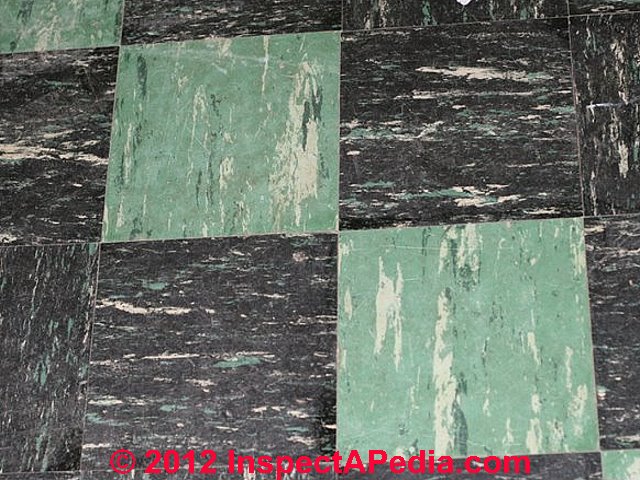 Reader question: We have some asbestos floor tiles in our basement from the 1950s that I am trying to identify.
Reader question: We have some asbestos floor tiles in our basement from the 1950s that I am trying to identify.
Our house was built around 1945 but we don't know for sure when these tiles were installed. I'm guessing anywhere between 1950 and 1975.
I believe them to both be Armstrong — from your site, I have determined that one is "Osage Green 780" but I can't figure out the black. I thought it was "Comanche Black 772" but it also has green in it.
Please see the below photo and let me know which brand, color and number you think these tiles are.
I can't afford to get these professionally tested for asbestos and am hoping you can help me identify them per your extensive documentation. - Anon
Reply:
In my OPINION there is no need to test these tiles, as the tiles in your photos are almost certainly from the Armstrong product series you've already identified.
I'll add your photo to the online examples, as I don't think ever published the green on black series asphalt asbestos floor tile series.
Reader Follow-up:
The reason I'm concerned about these tiles is that my daughters have been practicing irish dance in our basement for the past 6 months in their hard shoes (like tap shoes but wooden on the bottom instead of metal) and the tiles got pretty scuffed up from their dancing.
I hate to admit this but it took me a while for it to hit me that the tiles were probably asbestos.
From your experience, how much should I worry about asbestos dust that may have been released into our lungs and home from these tiles? We have since laid self-stick vinyl tiles over the top of all the scuffed ones, but I'm still worrying about what damage has been done to our health. Do you have any thoughts/opinions? I would appreciate it.
Reply:
In my opinion, the chances are the quantity of asbestos removed and airborne from your kids dancing an Irish jig on the floor was below the ability to detect, especially considering that the tiles were most likely coated with floor wax.
What releases problem levels of fibers and particles from asbestos floor tiles is more likely demolition, sanding, grinding, or potentially, buffing with a power buffer that uses a steel scrubber attachment. If you need to make certain what has gone on you'll need to hire an expert to collect settled dust samples, not just air samples.
See ASBESTOS FLOORING HAZARD REDUCTION for suggestions.
Can you identify this 1963 floor tile and tell if it contains asbestos?
 Reader question: Thank you for providing a useful site about asbestos tile.
Can you identify the tile I have and if it has asbestos in it?
I did not see the exact picture on your site. Any assistance is
greatly appreciated.
Reader question: Thank you for providing a useful site about asbestos tile.
Can you identify the tile I have and if it has asbestos in it?
I did not see the exact picture on your site. Any assistance is
greatly appreciated.
The house was built in 1963. The tiles are 12"x12" and are approximately 1.6 mm in thickness. The last picture shows the back of the tile. Regards, G.K., Cleveland OH
Reply: It's reasonable to presume that vinyl or asphalt floor tiles from the 1960's contain asbestos; only a certified lab can accurately state the actual asbestos content however.
We are not certain of the manufacturer of the tiles shown here, and we publish them here to invite feedback from other readers.
And of course only a certified asbestos test lab can say with certainty the tile asbestos composition.
But based on the floor tile age and pattern, it's reasonable to presume that these tiles contain asbestos fibers and filler.
The particle shape or pattern in your floor tiles is similar to the Armstrong floor tile Imperial pattern from 1963
see ARMSTRONG FLOOR TILES and scroll down to 1963). But the colors in your floor tiles (above left) resemble some hues found
in Kentiles (KENTILE KENFLEX ASBESTOS FLOOR TILE GUIDE
And while 9x9 floor tiles were common in the 50's and 60's there were indeed 12x12 floor tiles being produced and installed when your home was built.
We think that the hues in your tiles, even though the pattern is different, point in that direction.
I can't make out much from the photo of the back surface of a floor tile (above right) though on some tiles we may find text or numbers that help trace the floor's origin.
Also compare your tile pattern to those shown at our article on Wards floor tiles
at MONTGOMERY WARD ASBESTOS FLOOR TILE IDENTIFICATION as the color pattern is similar to some Wards flooring.
Does this floor tile from a house built in 1963 contain asbestos?
Reader asks: I did not see this tile in the photo displays but I am sure it is old. The house was built in 1963. Any advice?
Photos attached. I will gladly cover but the two surfaces are not level so one will need to be disturbed to fix it. Thank you for any information you may be able to share. Much appreciated. First time home buyer. - F.A. 8/21/2013
Reply:
The photos are a bit blurry (I did some sharpening in our lab) - so I'm not sure if we can match to an existing file photo or not.
If you look through Armstrong tile photos of the era of your house's construction1960 - 1969 Armstrong Excelon Floor Vinyl Plastic Asbestos Floor Tiles, 9" x 9" & beginning in 1960 available in 12" x 12" size
you'll see some similar but not matching patterns such as the Coda Bisque design or Nice Gold design.I'd also look at KENTILE KENFLEX ASBESTOS FLOOR TILE GUIDE - whose Carnival pattern suggests your flooring as well.
Unless tests are performed (usually not necessary) and results indicate otherwise, I would treat this flooring as PACM presumed asbestos containing material and handle it accordingly.We ask readers to let us know if you test the flooring and what you learn (a single asbestos test is not expensive, about $50. U.S.) - what we learn will help others.
Identify Asbestos-Containing Pebble People Floor Tiles, Etched Design, 1968 - 1973
Reader asks: 2019/01/26 Tammy said:
Can you please identify this tile? Home built 1968. 4 different tiles. Etched of some sort.
Reply:
We have seen that floor tile before, Tammy, identified by a reader as a 1973 "Pebble Peoples" floor tile, treated as presumed to contain asbestos
That discussion appears just below.
Pebble Peoples floor tile in a 1973 Chicago Home
I need help to identify these [pebble people floor tiles shown above] as seller refuses to let me test them and denies knowledge of asbestos. They are damaged and breaking peeling apart. definitely one of a kind
I'm buying a house and am worried about tiles which are curling and broken containing asbestos. the seller will not allow me to test them,
Assuming if they were positive I'd d then they would need to disclose that or issue a credit. the tile is one of a kind. house was built in 1973.
Please email me at jlovgren83@gmail.com if u can identify
This floor is installed in Chicago Illinois USA in a home built in 1973 - On 2018-03-10 by jlovgren83@gmail.com
Reply by (mod) - asbestos suspected in Chicago 1973 floor tiles
JL
Watch out: When a seller refuses to permit a buyer to discover whether or not the buyer may face a significant cost should she purchase the seller's property,
then
the seller is in essence telling the buyer that the buyer should simply assume that she does, indeed, face those costs.
That should be your assumption.
The flooring is pattern I have seen posted by several readers, one referring to it as "Pebble Peoples Floor Tile"It would help us research this floor design if you could tell us the country, city, state or province where the floor is installed.
Based on the age of the home and having no other information it would be prudent to treat the floor as presumed to contain asbestos.
What I want to say to the home seller and their real estate agent or lawyer is
"Let me get this straight: I'm buying a three quarters of a million dollar item from you and you want me to just slip my check under the door and keep walking, right?"
Cork pattern floor tiles that probably containing asbestos
Reader asks: Great website you have, it's been a good resource for me.
I suspect that these are asbestos tiles. Any idea? - G.M. 1/1/2013
Reply: vinyl asbestos floor tiles in cork pattern compared with true cork flooring materials
Your photos (above) look like vinyl-asbestos floor tiles in the cork pattern.
Actual cork floor tiles would be unmistakable as those would be actual cork material. Our photo above, for comparison, shows the cross-section of an actual true-cork floor tile. It's unmistakably a wood-product material even without microscopic examination.More photos of true cork flooring are
at FLOORING MATERIALS, AGE, TYPES and also
at FLOOR, RESILIENT VINYL or CORK
Take a look at ASBESTOS FLOORING HAZARD REDUCTION and also
see MASTIC, CUTBACK ADHESIVE, FLASHING CEMENT ASBESTOSReader follow-up:
My new plan is to replace the tiles I've already taken up with new tile, then put a floating wood floor over the top. According to everything I've read containment is the best way to go. Seeing as I have three other rooms with tile I think this is the easiest fix for me. What do you think?
Also, my tiles don't seem like vinyl to me. They're not plastic-y...if you know what I mean. Does vinyl get rigid?
Reply:
You can glue in floor tiles or use a leveling compound to make the floor smooth before installing a floating wood floor atop. Typically the floating floor will use a rosin paper or other underlayment as well. Makes sense to me.
Yes vinyl floor tiles can get very rigid and brittle; if the tiles are thick, say 1/8" and dark inside they may be asphalt based; else probably they're vinyl. I think that the cork pattern as well as other light-colored floor tiles will generally date back to early vinyl or "plastic" floor tiles.
One of the reasons manufacturers liked vinyl is that lighter colored flooring was easier to produce when you don't start with (black) asphalt.
Reader follow-up:
Okay, that makes sense. They're not dark inside though. So they must be vinyl. So, I'm just going to cover them up.
Does this Applause Vinyl Floor Tile Contain Asbestos?
Reader Question: I've been searching within inspectapedia and on other web sites to find info on this tile I found in my grandpa's garage. I had been cutting it with a bandsaw over the last 4 or 5 days (without any kind of mask).
This morning, before I continued cutting, it dawned on me that it might contain asbestos. The attached picture is what's left of the box that the tile was in, alongside the tile in question.
Thank you, - Anon [by private email] 2015/12/06
Reply: patent research suggests this flooring may contain asbestos
Stop cutting the flooring with a saw; it is certainly possible, even likely that it contains asbestos, though only by a lab test will we know for certain.
I have not seen this specific pattern of flooring and the packaging photo you included did not mention asbestos - not all does even when the flooring contains that material. I'd like to see a photo of the back of the tile and to know its dimension and thickness.
The floor tile product style name Applause is still in use by Tarkett flooring but for newer sheet or carpet-type flooring products that would not contain asbestos.
The vinyl tile data on the original packaging in your photo is incomplete but we can see the tile style name (Applause vinyl floor tile), a fragment of text probably indicating that the supplier and perhaps manufacturer of this flooring was in Alabama, and some patent numbers. But your packaging and the patent numbers put the product in a significantly earlier time frame. We also see that this is a12x12" vinyl floor tile, Style No. SC7G made in manufacturing run No. 04.
I researched the patents cited on the box. The last one specifically refers to a process that used asbestos - supporting my caveat. And all of the patents date from 1955-1965 - an era where asbestos was commonly used as both a filler and as a reinforcing fiber in vinyl flooring products.
If you can give more photos of any other markings on the packaging that'd be helpful; I'm researching the product name further.
Don't panic, and don't cut more tile.
If you decide to have the flooring tested for asbestos see ASBESTOS TESTING LAB LIST for some suggestions. Typically a lab fee is about $50. for asbestos materials testing.
Watch out: do not clean up the dust you made using an ordinary or shop vacuum cleaner as you may increase the level of airborne dust that may contain asbestos. Instead use damp wiping and/or a HEPA-rated vacuum cleaner.
Below are the patents cited on the packaging and excerpts discussing asbestos in this flooring. In some cases, because patents cite earlier patented inventions the package-patent number shows up more than once in research.
Applause Flooring Patents Indicating Asbestos in Vinyl Floor Tile
- Edward, Stanley Robbins. "Extrusion graining process." U.S. Patent 2,914,807, issued December 1, 1959.
Excerpts:
This invention relates to an improved process for the production of a marbleized or grained plastic sheet. Plastic sheetmaterial of this type has a background matrix of one color, in which one or more dilferently colored I portions of the same material'are distributed in a swirled, grained, or marbleized pattern.
This invention more particularly relates to a process for the manufacture of 'a grainedp'lastic sheet in which the density of thecolor in the grained 1 areas isflsfihstantially uniform throughout a given cross-section of the sheet.
This invention is particularly related to a process for producing uniformly grained plastic sheet material useful inthe production offiooring products, such as asphalt composition, rubber, and vinyl plastic floorocoverings and tiles;
There are a great [... text lost, probably "number of " ] processes now in use for the produvction of grained plastic sheets. In one such process, 2,914,807 Patented Dec. 1, 1959 rod-like multi-colored .memhers.
These multi-colored members are fed directly into a calender, which accumulates a mass of these rods in a random arrangement. in the nip of the calender and expresses the rods into a sheet In' this process the rods are attempted to be maintained in such a manner that the length of the mds [sic] is substantially parallel to the axes of the calender rolls.
... Where asphalt compositions are employed in this process, the added advantage is secured of orienting the asbestos fiber fillers in a desirable direction by the combination of compression in the extrusion apparatus and calendering. ...- Robbins, E. S. "Robbins Tile Sizing Machine and Method ." U.S. Patent RE 24,104, issued December 27, 1955. Original assignee: Robbins Floor Products. Original filing 16 March 1950.
Excerpt:
This invention relates to manufacturing and more particularly to a machine or apparatus and process for accurately squaring and sizing tile such as those formed of rubber, asphalt, wood, or other composition.- Slosberg, David K., Julian G. Clement, and Jr Walter Mutchler. "Conductive floor covering." U.S. Patent 3,386,001, issued May 28, 1968.
Excerpts:
This invention relates to conductive plastic sheet material, and more particularly to such material having an esthetically pleasing appearance in which the presence of the conductive material is minimized.
Conductive flooring materials have been made, either in sheet form or in tile form, comprising a plastic to which has been added a conductive material such as carbon black for the purpose of providing a path for electrical current in order to drain off any electrostatic charges that may have built up.
Such materials are used, particularly in industrial plants, where explosive materials or gases are present, in order to minimize or eliminate completely the buildup of such charges. As an example of such material, a conductive vinyl tile is made by marbleizing a non-conductive vinyl base with a conductive mottle.
The conductive mottle contains about of conductive carbon black. The marbleized material is then granulated to a 2 8 inch chip, and these chips are then consolidated by heat and pressure to form a slab which, with further treatment, will become the end product for use on floors as a covering.- "Applause III #02803", Tandus Centiva, a Tarkett Company, website page describing flooring products, retrieved 2015/12/06, original source: https://www.tandus-centiva.com/products/Applause-III-02803/color/28521
NOTE: this page describes floor covering for sale in 2016 and not asbestos-containing products.
How can I Submit a Floor Tile Photo for Identification?
(Apr 3, 2014) Anonymous said:
How can I submit a photo of a tile to see if it might contain asbestos?
Reply:
Sure, Anon, just use the email found at our CONTACT link seen at the top or bottom of any InspectApedia.com page - but it may not be necessary.
If you've got vinyl or asphalt floor tiles installed before the early 1980's it would make sense to treat them as presumed to contain asbestos (PACM or "Presumed Asbestos Containing Material") - and to avoid making a dusty demolition, sawing, grinding mess.
If you have tried looking through our example flooring photos by year or flooring manufacturer and were unable to identify your flooring then feel free to CONTACT US to send along photos and a description (age, dimensions, building history) of flooring that you are unable to identify
Asbestos is safe and legal to remain in homes or public buildings as long as the asbestos materials are in good condition and the asbestos can not be released into the air
- Please, before sending us email asking to identify floor tiles, sheet flooring, linoleum, etc. try using our
ASBESTOS FLOORING IDENTIFICATION procedure or our photo catalog of floor tiles and sheet flooring that may contain asbestos
beginning
at ASBESTOS FLOOR TILE IDENTIFICATION PHOTOS 1949-1959 - For identification guides to all brands of asphalt asbestos, vinyl asbestos, and similar flooring products
see FLOOR TILE / SHEET FLOORING PHOTO GUIDES - list of photo guides - To identify unknown flooring products:
at ASBESTOS FLOOR TILE PHOTO ID REQUESTS we include additional photographs of both tile and sheet flooring products submitted by readers with requests for more information. - To identify resilient or sheet flooring or sheet-forms of resilient flooring that may contain asbestos are now found
at RESILIENT SHEET FLOORING ID GUIDE.
...
Reader Comments, Questions & Answers About The Article Above
Below you will find questions and answers previously posted on this page at its page bottom reader comment box.
Reader Q&A - also see RECOMMENDED ARTICLES & FAQs
On 2023-03-27 by Susan Miller - 1965 Congoleum-Nairn Plastic Tiles - flooring asbestos hazard?
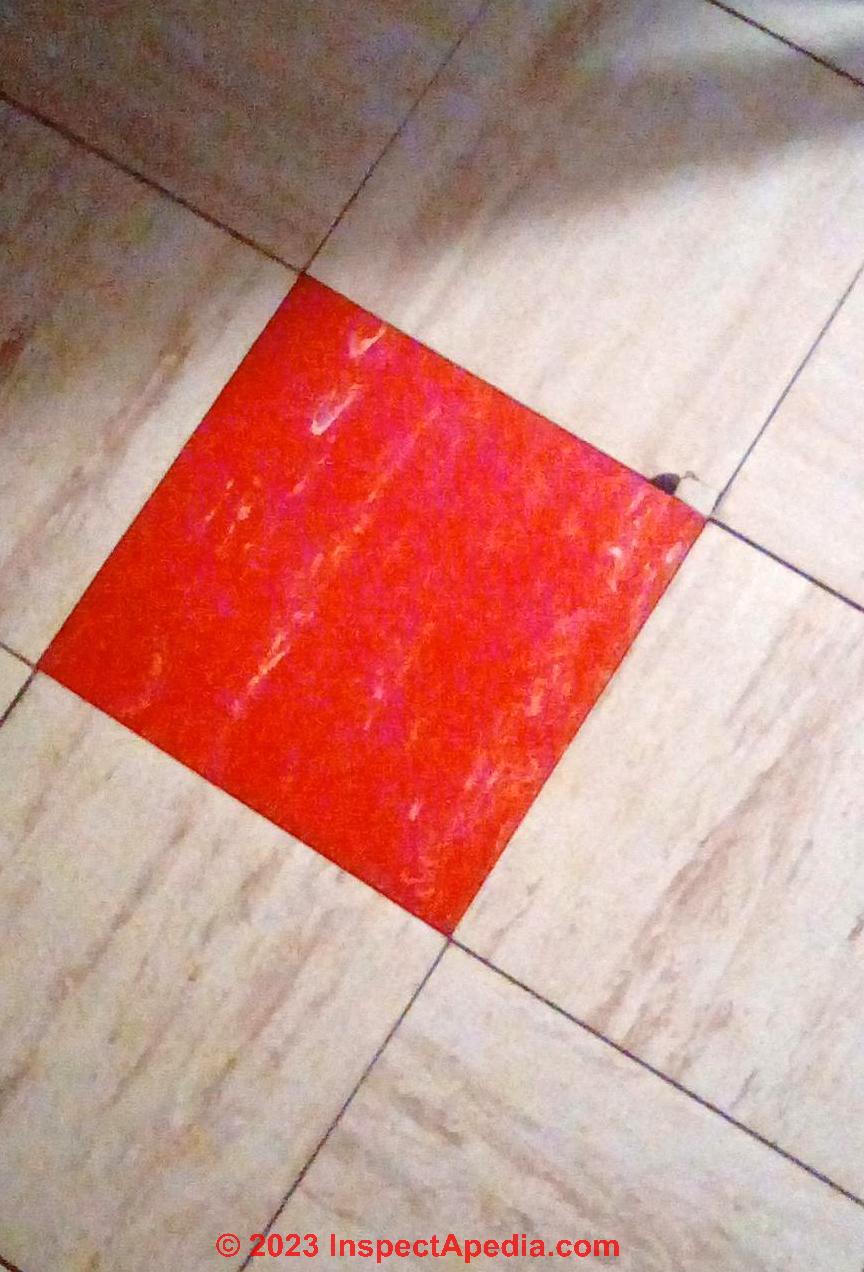 I have tiles in my kitchen that were put down in 1965. The box said Congoleum-Nairn Plastic Tiles. Are they just plastic, they are very thin. Some have chips and by my radiator are loose.
I have tiles in my kitchen that were put down in 1965. The box said Congoleum-Nairn Plastic Tiles. Are they just plastic, they are very thin. Some have chips and by my radiator are loose.
Reply by InspectApedia Publisher
@Susan Miller,
Thank you for the 1965 Congoleum flooring asbestos question.
The word "plastic" is not used consistently across all sources and in this context includes includes vinyl or other not-asphalt-based flexible (not ceramic, wood, or other non-plastic materials) flooring.
That is to say vinyl is a sort of "plastic" material and plastic in general simply means flexible.
So we think that when Congoleum-Nairn used the word "plastic" that served as a synonym for vinyl - or at least, second generation floor tiles where first generation were asphalt-based and second generation were vinyl or "plastic" based.
Both formulas made wide use of asbestos, last-use date varying by country, though as you'll find in this article series, even during the "asbestos floor tile era" not all vinyl floor tiles contained asbestos.
Best guess: 1965 Congoleum plastic (vinyl or similar formula) (not asphalt-based) floor tiles
see details at
CONGOLEUM-NAIRN FLOOR TILES & LINOLEUM
where you'll read that
Some Congoleum flooring manufactured between 1947-1984 contained asbestos.
also see
CONGOLEUM WHITE SHIELD BACKING ASBESTOS in FLOORING https://inspectapedia.com/hazmat/Congoleum_Vinyl_Asbestos_Floors.php#WhiteShield
If your Congoleum floor tiles are well-adhered, minor chips are not significant damage; best, safest, and least expensive is to leave the flooring in place and cover it over with a new material.
If you wanted to simply coat the flooring with a suitable floor paint, the cost of that would be less than of a test for asbestos.
Options are at
ASBESTOS FLOORING HAZARD REDUCTION
Please use the "Add Image" button to post photos (one per comment) of each side of the Congoleum tile box that contains printed information, and also check the back of the floor tiles and post a photo of that surface.
On 2022-11-28 by Michelle Stricklen - does this 1960s floor tile contain asbestos?
This house was built in 1960 in Ohio. Pulled up carpet and padding to find some glue residue and the tan floor tiles. We’re wondering if it is asbestos.
On 2022-11-28 by InspectApedia (mod)
@Michelle Stricklen,
Given its age, it would be wise to treat the floor in your photo as presumed to contain asbestos - which is not a reason to panic but it is a reason to avoid creating dust and debris.
Take a look at this article to perhaps get a clearer answer:
DOES THIS FLOOR CONTAIN ASBESTOS? - 5 easy questions (live link above in the Recommended Articles list)
Keep in mind that the simplest and safest choice is to leave the flooring in place, seal it if in good condition, or cover with a new flooring of your choice.
Also see
HOW TO SEAL ASBESTOS FLOOR TILES TO LEAVE IN PLACE
On 2022-11-12 by Dawn Burkley - selling our 1962 home: advice for these "linoleum tiles"?
My parents have moved to an assisted living facility. Family is getting 1962 house ready for resale. When old carpet was pulled for new flooring, we found linoleum tiles. What is your advice?
On 2022-11-12 by InspectApedia (Editor) - getting 1962 house ready for resale
@Dawn Burkley,
HEPA Vacuum up debris, damp wipe, and sell the home "as-is".
If a buyer is frightened or gouges you as seller about that floor I'd point them to
ASBESTOS FLOORING HAZARD REDUCTION https://inspectapedia.com/hazmat/Asbestos-Flooring-Hazard-Reduction.php
The safest and most recommended advice for an asbestos-suspect tile floor is to leave it in place and cover it over.
Certainly from simple light foot traffic of people walking through the home to look at it there will not be a detectable asbestos hazard even if that floor does contain asbestos.
*IF* you uncover such flooring in cases of loose or crumbling floor tiles, that's more-hazardous and would deserve additional steps.
On 2022-10-12 by Nancy Germundson - Do these cork tiles contain asbestos?
My daughter has cork tiles in her hallway and by her front door. Here is a picture of the tiles next to the hardwood. We removed the carpet off them yesterday then belatedly wondered if they were asbestos.
Can you help us out? They are true cork based on pulling up the nails for the tack strip.
The ones by the front door should have been listed in the inspection report, right? The tiles that are asbestos in the basement were listed. Thanks for any help you can give to me
On 2022-10-12 by InspectApedia (mod) - true cork flooring unlikely to contain asbestos
@Nancy Germundson,
If it is true cork flooring, it would not contain asbestos.
Read more at
CORK FLOORING GUIDEThere you'll see our definitive guide to identifing real cork floor tiles - those are a wood product (made from bark from cork trees).
On 2022-08-31 by Tammy - I need help identifying these floor tiles
Need help identifying this Flooring. Thank you
On 2022-08-31 by InspectApedia (mod)
@Tammy,
We cannot identify the brand or exact pattern name of those floor tiles from a photo alone, but it does look like a vinyl- or vinyl-asbestos floor tiles produced after around 1960.It would be wise to treat the floor in your photo as presumed to contain asbestos - which is not a reason to panic but it is a reason to avoid creating dust and debris.
Since we know nothing about the age or location of your floor, take a look at this article to perhaps get a clearer answer:
DOES THIS FLOOR CONTAIN ASBESTOS? - 5 easy questions (live link above in the Recommended Articles list)
Keep in mind that the simplest and safest choice is to leave the flooring in place, seal it if in good condition, or cover with a new flooring of your choice.
Also see
HOW TO SEAL ASBESTOS FLOOR TILES TO LEAVE IN PLACE
On 2022-06-28 by Jeff Koenig - Our plan is to restore this 1963 floor tile in our Missouri home: any advice about sealing it?
We just bought this home. Built in 1963. We pulled off some nasty tan brown tiles to find this beautiful turquoise broken glass looking tile.
Curious if you recognize it. We plan on taking off all of the tan tiles, cleaning the turquoise floor up, sealing it and letting her shine in all of her 1960’s glory.
On 2022-06-28 by InspectApedia-911 (mod)
@Jeff Koenig,
I like that flooring too. It's not a pattern that I've seen before.Where is the building located?
On 2022-06-28 by Jeff Koenig
@InspectApedia-911, I live in Ozark MO. I have not pulled off enough of the tan tiles to measure how big the turquoise tiles are. I know 9” x 9” can be a give away for asbestos products.
I might just assume that it contains asbestos and wear masks and gloves while cleaning and sealing. Any recommendations for a product to seal the tiles?
On 2022-06-29 by InspectApedia (mod) - save and seal nice turquoise tile: clear encapsulant options
@Jeff Koenig,
If you're going to retain and preserve the original floor tile you would choose a clear sealant coating.
Depending on the severity of floor traffic that you expect, you'd use either a clear epoxy coating (more work, longer to dry, very durable) or any of a number of clear flooring sealants such as:
- Epodex Clear Epoxy Flooring Kit - web: epodex.us - used on hard wear surfaces such as garage floors or industrial surfaces.
- ESD Floor Finish - from Uline
- Perfect Primer - Clear Encapsulant - web: https://perfectprimer.com/ Note that the company sells pigmented white encapsulants as well as clear coatings. Water soluble. The companhy also sells clear epoxy floor coatings.
- Sentinal Formula 811LE Lockdown Encapsulant from Sentinel Products, Inc. This coating goes down opaque but dries to a clear hard solultion, commonly used to "lock down" any stray asbestos particles/fibers after an asbestos remediation job.
- Tuff Glaze 5 - this is a clear, high floss waterborne acrylic sealer widely available from building suppliiers such as Home Depot and Grainger
- Tuff Guy Hard Surface Finish - from Grainger.com
If elsewhere in your building you are going to leave asbestos-containing flooring in place but then cover it with new flooring then you'd take a look at this article for our recommendations for sealing asbestos flooring:
ASBESTOS FLOOR SEALANTS
On 2022-06-03 by Jacob Hood - tearing up old floor tiles I found some white substance beneath: is that dangerous?
Hey, so I'm tearing up carpet in a house I just bought. The house was built in 1960. I'm coming across a white substance under the tiles that I'll attach a pic of. And also what the tiles look like.
On 2022-06-03 by InspectApedia-911 (mod) - white tile mastic adhesive
@Jacob Hood,
I can guess at the white substance in your second photo - it may have been a floor leveling compound or simply a mastic adhesive: but the floor tile and mastic or filler hould be treated as presumed to contain asbestos.
See the flooring removal articles recommended above including
ASBESTOS REMOVAL, WETTING GUIDELINES
On 2022-04-24 by Lengman - advice for these red and cream floor tiles of unknown age & other large "sheets" of flooring: asbestos?
Hi, what do you think to these. They are in pretty immaculate condition really so not sure how old they are.
There are the red and cream tiles in the hall, then large sheets of red flooring in the dining room.
I am very doubtful of the large sheets containing asbestos due to the size, looks as if it came off a roll and the fact it is cut around a wall that is part of of a post millennium open plan making job.
On 2022-04-24 by Inspectapedia Com Moderator - red and cream floor tiles and red sheet flooring may all contain asbestos
@Lengman,
I may have misunderstood you but if you're saying that you think that large piece of flooring tell you whether or not the material contains asbestos, that's a mistake.Watch out: Asbestos was used in both floor tiles and in tiles or other shapes of all sizes and also in sheet flooring.
The last date used for asbestos depends on the country where your flooring products were made.
On 2022-02-18 by Alicia Barnett - does this old bath floor ceramic tile contain asbestos?
I removed the old flooring in my bathroom to find some really beautiful mosaic tile. It looks to be ceramic. What’s the chances it has asbestos?
On 2022-02-18 by Inspectapedia Com Moderator - Asbestos in ceramic tiles may be present
@Alicia Barnett,
Asbestos in ceramic tiles may be present depending on the country of origin.
See
DOES THIS FLOOR CONTAIN ASBESTOS? - 5 easy questions to tell if your FLOOR probably contains asbestos -
https://inspectapedia.com/hazmat/DIY-Asbestos-Floor-Test.php
and be sure to also read
CERAMIC TILE, ASBESTOS
for a more-complete understanding of the same question and our answer that you'll find there.
On 2021-12-12 by Bob
@Inspectapedia Com Moderator, Thank you. I do see those similar matches and that is what I was afraid of having already disturbed it. Plan is to dampen and clean up the mess, then cover it over. Much appreciation for this database and your time.
On 2021-12-12 by Inspectapedia Com Moderator
@Bob,
We're glad to be of assistance.
You'll also find in this article series guidelines on reducing the hazard from asbestos-containing flooring, including cleanup procedures and cover-up procedures.
On 2021-12-11 by Bob - is this 1958 flooring likely to contain asbestos?
S.E. Wisconsin home built in ‘58. This floor is under carpet in a sunroom addition that showed up on a plat of survey from ‘84. So not sure when the room was added or when this floor was laid.
Any help in identifying would be appreciated. We were planning on putting lvp over top but some of the sheet flooring is raised and cracking. I started to peel away at it before I thought to check if it could contain asbestos.
On 2021-12-11 by Inspectapedia Com Moderator
@Bob,
Yes that floor is likely to contain asbestos - you'll find a very close match in our photos from the 1960s and 1970s
That flooring might contain asbestos if it was installed in a building in North America before 1987. From a photo one can’t answer your question with certainty. Popular flooring patterns were continued, without asbestos, after 1986.
Have a sample of the flooring tested, or you can make a reasonable *guess* at whether or not the floor contains asbestos by answering the few easy questions found at:
DOES THIS FLOORING CONTAIN ASBESTOS? - 5 easy steps that can help you make a reasonable guess at whether or not the floor you ask about contains asbestos.
You can also review the extensive pattern index found here:
INDEX TO ASBESTOS FLOORING
Asbestos is safe and legal to remain in homes or public buildings as long as the asbestos materials are in good condition and the asbestos can not be released into the air. - US EPA
The safest and least costly approach is to leave the flooring alone, in place, and to cover it with new material.
If the floor is in poor condition or must be removed then see the asbestos floor removal and asbestos hazard reduction articles found in the ARTICLE INDEX at the end of any of these pages.
On 2021-10-22 by Courtney - do these 1965 vinyl tiles contain asbestos?
Do you think these vinyl tiles have asbestos? The house was built in 1965.
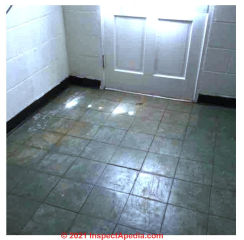
Here is an additional photo for the 1965 vinyl flooring
On 2021-10-22 by Inspectapedia Com Moderator
@Courtney
Short of having a sample of the flooring tested, you can make a reasonable *guess* at whether or not your floor contains asbestos by answering the few easy questions found at
DOES THIS FLOORING CONTAIN ASBESTOS? - 5 easy steps that can help you make a reasonable guess at whether or not the floor you ask about contains asbestos.
inspectapedia.com/hazmat/DIY-Asbestos-Floor-Test.php
At the very least, if you can establish the date that the flooring was made or installed then, depending on the country where the flooring was made (and usually where it's installed) you can know if it's an asbestos-candidate.
If that leaves you with suggestions or questions do let me know.
As you may have seen, you can often find a match in the ID-library of asbestos flooring beginning
at ASBESTOS FLOOR TILE IDENTIFICATION - (floor tiles) inspectapedia.com/hazmat/Asbestos-Floor-Tile-Identification.php
On 2021-08-29 by Bea - what is this marble or embedded polished stone floor made-of?
Hi, please can you identify this? I’m not sure what it is made of. Thanks
On 2021-08-29 by Inspectapedia Com Moderator
@Bea,
It looks like a masonry product- a terrazo type floor tile.
Can you see an edge of the material anywhere?
Terrazzo flooring can also be poured in place but then we'd not see those joints.
Here's a photo of modern Terrazzo floor tiles, in 16" x 16" format, sold by Tile Bar https://www.tilebar.com/
On 2021-08-18 by Kathy - likely asbestos in 1968 cork pattern floor tile?
Hello, this tile was found under wall to wall carpet in the family/patio room of our new to us old house… a split level built in 1968. We removed all the other carpeting and tack strips in the house and luckily found hard wood but this one gave us pause.
Likely asbestos? The tile looks good but removing the tack strips will obviously disrupt it.
Would it best to just put a floating floor over it? Any advice greatly appreciated.
On 2021-08-18 by Inspectapedia Com Moderator
@Kathy,
Several manufacturers, including Armstrong, Sears, Wards and possibly Kentile produced a vinyl-asbestos floor tile in that pattern, referred to as "Corkstyle"
I recommend the procedures you'll find at
ASBESTOS FLOORING HAZARD REDUCTION
Above: asbestos suspect sheet flooring from the 1960s, from reader Kat.
On 2021-06-17 by Rebekah - what is this wood like material found under our carpet
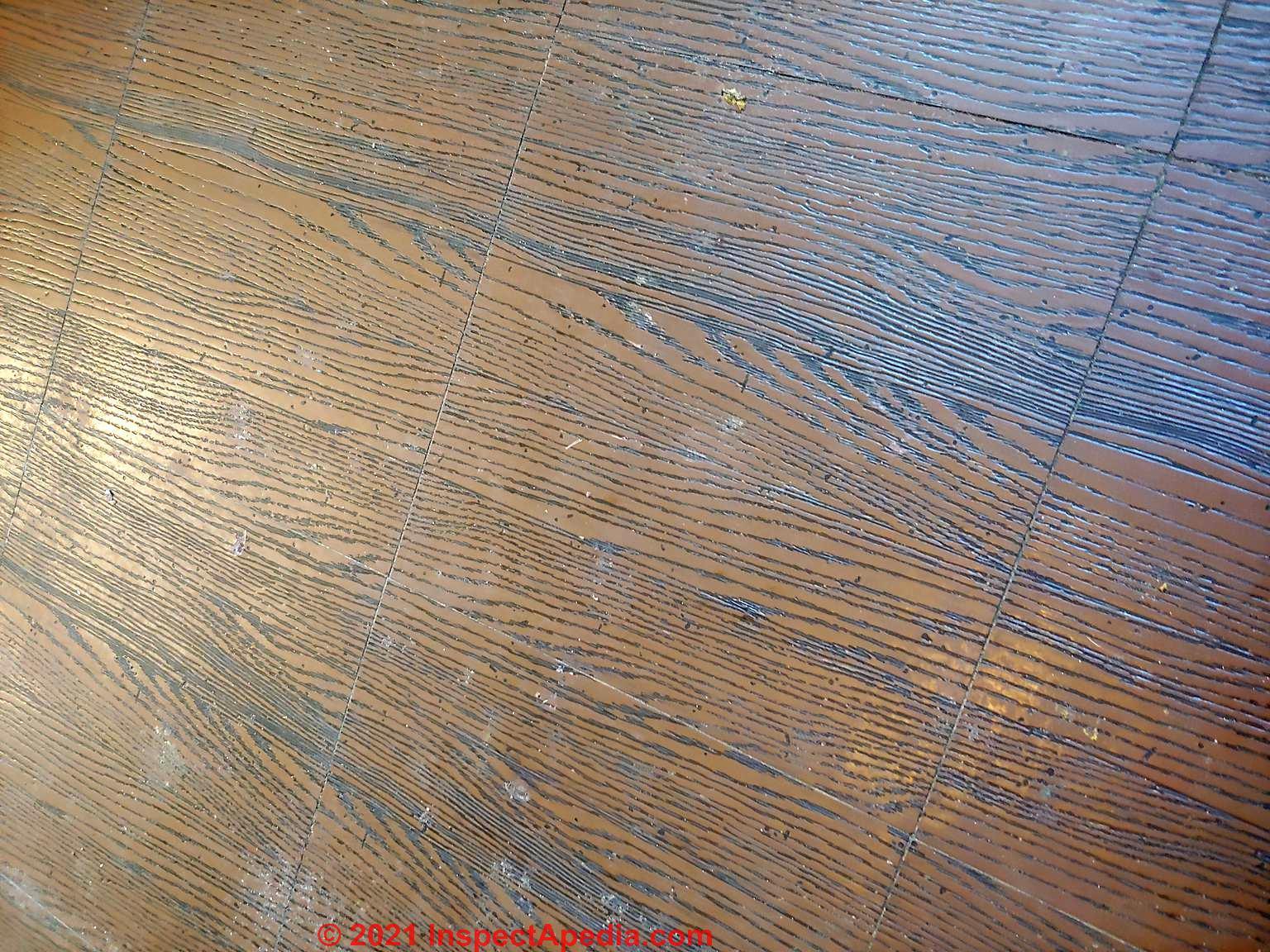 We just uncovered these beauties under carpet as we are prepping to install wood flooring.
We just uncovered these beauties under carpet as we are prepping to install wood flooring.
They go through the whole house.
My first question was, what the heck is it?
My second was WHY?
On 2021-06-17 by inspectapedia.com.moderator (mod) - metaphysical questions about brown wood pattern vinyl floor tiles
@Rebekah,
That looks like a vinyl floor tile in a wood grain pattern.About your metaphysical question of Why?
Why what? Why was it installed?
Without a shred of contextual information about your building any reply I might infer would be too speculative to be helpful.
But certainly many homeowners installed vinyl flooring in tile or sheet form to give a wearable, easy-to-clean surface whose appearance they liked.
On 2021-03-22 by Geraint - polished marble stone like floor tiles - have you seen this design before
I have just purchased a 1960’s bungalow and came across your site whilst researching the unique tiles I have in the hallway. After reading this article I am concerned that asbestos might be present. Has anyone come across this tile design before?

On 2021-03-22 by (mod)
@Geraint,
I am not familiar with that exact pattern, but it looks like a polised stone floor tile, probably a vinyul product.
You can make a more useful guess about the asbestos question by clicking the live link in the article recommendations titled
DOES THIS FLOOR CONTAIN ASBESTOS? - 5 easy questions to tell if your FLOOR probably contains asbestos
On 2021-03-22 by Geraint
Thank you for the quick response. I will do that.
On 2021-01-19 by Jane Fallek - husband has been laying floors since 1960 now has Parkinson's Disease. Asbestos related?
My husband has been laying floors since 1960. Some of the tile he layed had asbesyos but also some of the adhesives. He has now been diagnosed with Parkinson's. Anyone else have that problem from asbestos?
On 2021-01-1 by (mod) - Research on Asbestos exposure and Parkinson's Disease
Jane,
I have not found research asserting that exposure to asbestos is a cause of Parkinson's but there are medical complications or interactions possible where both are present in one individual;I'll include some research below.
Of course floor tiles and mastic are not friable but if your husband used power tools to cut, saw, grind, or demolish such flooring he could have been exposed to asbestos dust.
Keep in mind that solvents used in flooring mastic adhesives or glues, sealants, and coatings may also have contained chemicals that could have a medical effect on workers exposed to their fumes.
Research on Asbestos exposure and Parkinson's Disease
- Hillerdal, Gunnar, J. Lee, A. Blomkvist, Anna Rask-Andersen, M. Uddenfeldt, Hemin Koyi, and E. Rasmussen. "Pleural disease during treatment with bromocriptine in patients previously exposed to asbestos." European Respiratory Journal 10, no. 12 (1997): 2711-2715.
Abstract excerpt:
Bromocriptine, which is used in the treatment of Parkinson's disease, can cause adverse pleuropulmonary reactions. Exposure to asbestos can result in similar lesions.- Pascolo, Lorella, Alessandra Gianoncelli, Giulia Schneider, Murielle Salomé, Manuela Schneider, Carla Calligaro, Maya Kiskinova, Mauro Melato, and Clara Rizzardi. "The interaction of asbestos and iron in lung tissue revealed by synchrotron-based scanning X-ray microscopy." Scientific reports 3, no. 1 (2013): 1-11.
- Knoop, Christiane, Michel Mairesse, Christine Lenclud, Pierre-Alain Gevenois, and Paul De Vuyst. "Pleural effusion during bromocriptine exposure in two patients with pre-existing asbestos pleural plaques: a relationship?." European Respiratory Journal 10, no. 12 (1997): 2898-2901.
And as you and your husband may know and certainly as your doctors will know, there are other exposures that are, unlike asbestos, cited as causal or exacerbating Parkinson's, for example;:
- Ascherio, Alberto, Honglei Chen, Marc G. Weisskopf, Eilis O'Reilly, Marjorie L. McCullough, Eugenia E. Calle, Michael A. Schwarzschild, and Michael J. Thun. "Pesticide exposure and risk for Parkinson's disease." Annals of Neurology: Official Journal of the American Neurological Association and the Child Neurology Society 60, no. 2 (2006): 197-203.
Excerpts:
Results
Exposure to pesticides was reported by 7,864 participants (5.7%), including 1,956 farmers, ranchers, or fishermen. Individuals exposed to pesticides had a 70% higher incidence of PD than those not exposed (adjusted relative risk, 1.7; 95% confidence interval, 1.2–2.3; p = 0.002).
The relative risk for pesticide exposure was similar in farmers and nonfarmers. No relation was found between risk for PD and exposure to asbestos, chemical/acids/solvents, coal or stone dust, or eight other occupational exposures.
Interpretation
These data support the hypothesis that exposure to pesticides may increase risk for PD. Future studies should seek to identify the specific chemicals responsible for this association. Ann Neurol 2006
- Seidler, A., W. Hellenbrand, B-P. Robra, P. Vieregge, P. Nischan, J. Joerg, W. H. Oertel, G. Ulm, and E. Schneider. "Possible environmental, occupational, and other etiologic factors for Parkinson's disease: a case‐control study in Germany." Neurology 46, no. 5 (1996): 1275-1275.
Research on Parkinson's or Neurological Effects from Exposure to Chemical Solvents in Flooring Adhesives or Coatings or similar products
- Hageman, G., J. A. F. van der Hoek, M. S. E. van Hout, Gert van der Laan, Ernst Jansen Steur, W. I. De Bruin, and Karl Herholz. "Parkinsonism, pyramidal signs, polyneuropathy, and cognitive decline after long-term occupational solvent exposure." Journal of neurology 246 (1999): 198-206.
- Lotti, M., and M. L. Bleecker. "Neurotoxicity of solvents." Occupational Neurology (2015): 93.
Google search result excerpt:
… of parkinsonism and long-term occupational exposure to … loss of DA nerve terminals than in Parkinson’s disease, and also a … follow up of formerly exposed floor layers and their controls.- Nilson, L.N., Sällsten, G., Hagberg, S., Bäckman, L. and Barregård, L., 2002. Influence of solvent exposure and aging on cognitive functioning: an 18 year follow up of formerly exposed floor layers and their controls. Occupational and Environmental Medicine, 59(1), pp.49-57.
- Sainio Sr, Markku Alarik. "Neurotoxicity of solvents." Handbook of clinical neurology 131 (2015): 93-110.
On 2020-11-29 by Sally Fisk - Do you think these spatter pattern floor tiles contain asbestos?
Have uncovered these floor tiles in my parents' 1960s built house. Do you think they contain asbestos?
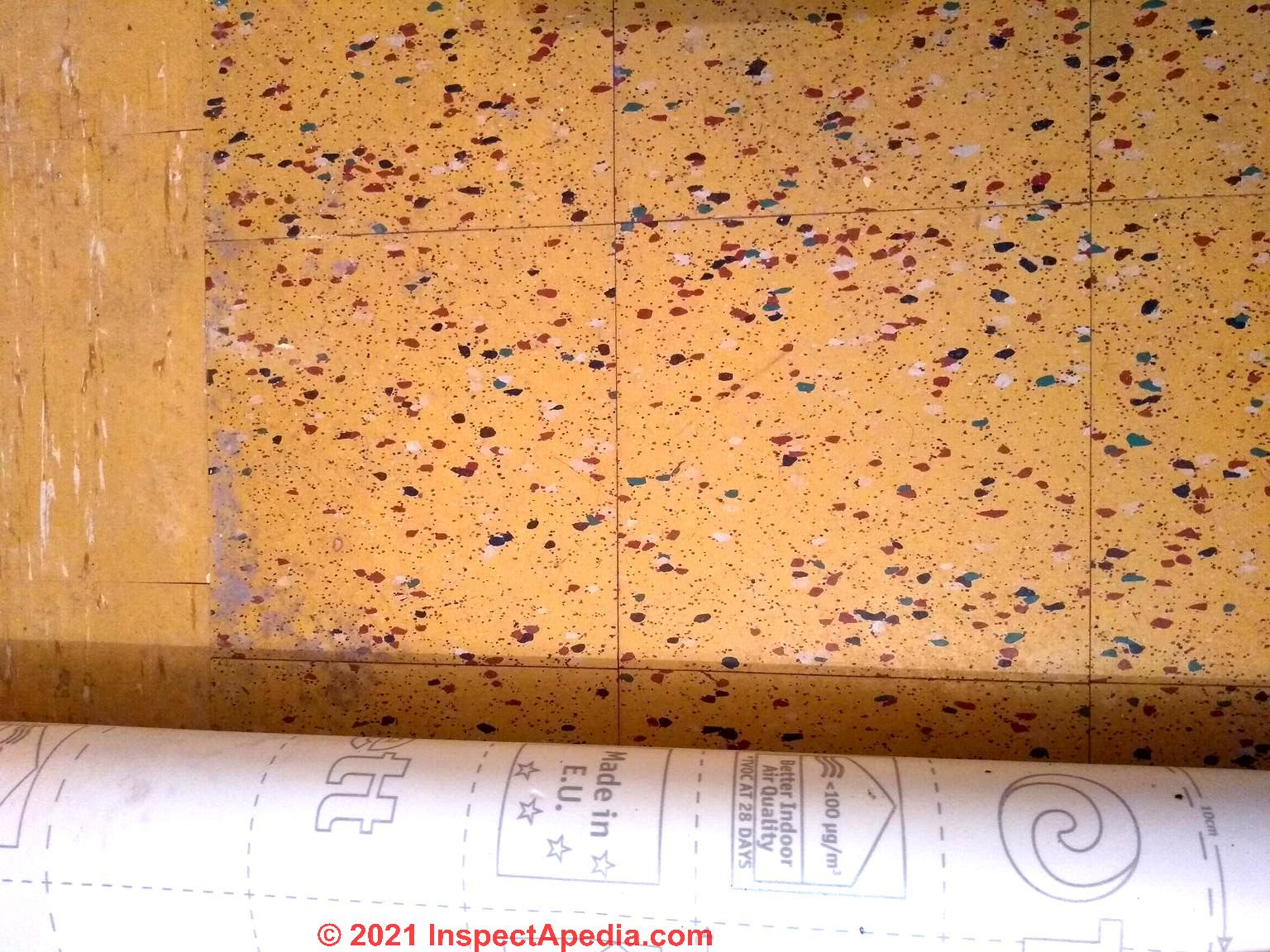
On 2020-11-29 - by (mod) - yes
Yes; that looks like a spatter pattern vinyl asbestos floor tile.
On 2021-01-01 by prd
What about the floor about the spatter pattern? We have tiles like the top ones.
On 2021-01-01 1 - by (mod) -
The article above notes that floor tiles of that age and pattern are likely to contain asbestos
On 2020-11-08 by eri
So, you seem to be that independent person I asked about. smiles. So, more questions: some of the tiles are not securely attached. They aren't loose, but they make a sound when you walk over them which leads me to believe they aren't secure What would you suggest for them?
Also should we put something over the tiles to encapsulate before we lay the flooring? and finally what would you suggest for the flooring? I've been reading up and it seems any flooring is okay even adhesive stick on.
May I make a donation to your website for all you've done?.
On 2020-11-08 - by (mod) -
From your text I don't know what the sound is that you are describing but if the sound is one that suggests that the tiles are not well adhered then you may need to remove them before installing another layer of flooring. It depends in part on what kind of flooring you are installing. For example you wouldn't install another layer of tile or sheet flooring over loose floor tiles but you might be able to install a laminate floor where there are a couple of loose floor tiles.
Thank you for your comment about independence. Here's more detail on that point.
InspectAPedia.com provides building and environmental diagnostic and repair information.
In order to absolutely assure our readers that we write and report without bias we do not sell any products nor services, nor do we have any business or financial relationships that could create such conflicts of interest.
On 2020-11-09 by eri
Well, then, thank you for all your patience and kind willingness to help. Your site is different than any I've seen. Quite special.
On 2020-11-09 - by (mod) -
Eri
thank you for your comment. We've worked hard on this material for many years and are very grateful when readers find it useful. We also very much welcome any criticism, questions, content suggestions. To protect your trust we have no business or other relationship with any product service or provider discussed here.
On 2020-11-01 by eri - Is our chipping loose 1950s or 1960s floor tile (Long Island NY) dangerous? btw just found this site and it's amazing.
 The tile in the basement (from the 50's or 60's) is coming up in a few places (flood)...a couple are chipped.
The tile in the basement (from the 50's or 60's) is coming up in a few places (flood)...a couple are chipped.
Is this becoming dangerous? and if so, what's the best way to find a reputable company and how much should we expect to pay for removal for an area approx 400 sq feet. btw just found this site and it's amazing.
Thank you so much (nassau county long island)
On 2020-11-02 - by (mod) - asbestos hazard from un-damaged floor tiles is low; if breaking up & making dust treat with caution
Eri
Asphalt asbestos or vinyl asbestos floor tiles, when they are intact, are not friable and so are not easily made into hazardous Airborne dust. But when the tiles begin to come loose and in particular if they are breaking up into multiple pieces, each of those breaks has the potential of releasing a small amount of dust.One or two broken floor tiles in my experience is not going to produce even a measurable level of Airborne asbestos but as the floor continues to deteriorate and in particular if it's breaking up in normal use then it does need to be addressed.
That means either having loose tiles removed and feeling in those openings with new floor tile or better is removing all of a loose tile and then covering over the floor with a new material. That's the least expensive and safest and most recommended approach.
Take a look in the page top experts directory and you'll see some information about asbestos abatement companies.
But the bottom line is you need to call some local people and get some bids from them.
I find the prices for asbestos floor removal or sealing and covering vary considerably across North America depending on where you live
On 2020-11-07 by eri
I hope it's okay I'm posting again. I need some more of your expertise and advice.
This house in the tri state area is an older family member's, so the rest of the family got together to discuss.
One suggests we test the material.
Though I don't see tiles that look exactly like this, the tiles look similar to the asbestos tiles in your picture library.
Testing would take weeks to find out. Another doesn't consider the tiles a hazard. She thinks the 'fear' is way overblown.
But you can see that,certainly, a couple have chipped but others are coming up and you can hear that when you walk on them. Another person suggested that even if we get estimates from different companies we probably won't be able to trust them.
That person suggested we get someone who is independent of the asbestos removal companies (assuming these are asbestos tiles) who could look at the area and .tell us what to do in our best interest.
My questions to you: a, do you think that these look enough like the tiles that have asbestos that we really don't have to test?
b. do you think these tiles pose a hazard (unlike one of the family members who does not)
c. do you suggest we get this independent person to give us an opinion or do you believe that the remediation companies will be honest?
if you think we find this person, are there such people around? Thank you. I don't know where I would trust answers as much as I do from this site.
On 2020-11-07 - by (mod) - older Armstrong corkstyle vinyl floor tiles are likely to contain asbestos
Of course it's okay for you to post again Eri.
That floor tile looks like Armstrong's "corkstyle" that is likely to have asbestos; if you're confident it was installed before 1986 then you'd treat it as presumed to contain asbestos.
That does not mean you need to panic nor to rip up the floor. At least in your photo I don't see extensive breaking up of the floor tiles. But there are some broken corners and at least one loose tile.
If most of the floor tiles are securely adhered, then the safest, most-economical, and expert-recommended is to leave such a floor in place, covering it over with new flooring.
See ASBESTOS FLOORING HAZARD REDUCTION https://inspectapedia.com/hazmat/Asbestos-Hazard-Reduction.php
On 2020-10-28 by Sue - Is this good-condition 1963 covered-over floor tile in Freeport safe?
 This is in a 1963 house in Freeport. In a Tri-level home on the ground floor. It is covered by carpet for the most part, appears to be glued down, except for a closet that has shelving above the flooring.
This is in a 1963 house in Freeport. In a Tri-level home on the ground floor. It is covered by carpet for the most part, appears to be glued down, except for a closet that has shelving above the flooring.
Asbestos is safe and legal to remain in homes or public buildings as long as the asbestos materials are in good condition and the asbestos can not be released into the air.
Isn't this correct?
On 2020-10-28 - by (mod) - yes, floors in good condition, not being demolished are generally safe
Yes that statement that you see on many of our asbestos-information pages is a direct quote from US EPA guidance on asbestos-containing materials including flooring.
Above: a 1949 Linoleum floral pattern rug from reader Robinson. The asphalt-impregnated felt backer on some linoleum rugs like this contains asbestos. Avoid making a dusty mess.
On 2020-01-03 by Reno-man - worried that this Armstrong sheet flooring contains asbestos
I am concerned if this sheet flooring contains asbesto. I saw part of the word "strong" so I believe itArmstrong
On 2020-01-04 by (mod) -
The age of your sheet flooring is important in deciding if it might contain asbestos, as well, of course, as where it was manufactured because different countries banned asbestos at different times.
Take a look at the simple questions at DOES THIS FLOOR CONTAIN ASBESTOS?
On 2019-12-31 by nikki - what do we do to make this asbestos-suspect flooring safe if we don't want to remove it?
I just purchased a house built in 1961, the kitchen, den and main living room all have what looks to be asbestos tile.
It is all glued on really well and not crumbled at all. We are thinking of covering it with hard wood or regular tile. It that a safe alternative to removing? Do not want to remove it. Please advise.
On 2019-12-31 by (mod) - easy: cover it with a new layer of flooring material
Covering asbestos suspect flooring is the safest and most-recommended procedure, Nikki.
Also see ASBESTOS FLOORING HAZARD REDUCTION
On 2019-12-27 by Angie - what do we do about this old flooring found under old linoleum?
Trying to identify this material and decide what our next steps should be in our new home. We pulled up old linoleum and found this underneath
On 2019-12-27 by (mod) -
Angie take a look at the simple questions at DOES THIS FLOOR CONTAIN ASBESTOS?
But your floor sure looks to me like ceramic tile.
On 2019-12-15 by Jamie - is it safe to pull up this old 1960s linoleum?
Hi we have a 1962 home with 2 layers of linoleum in the kitchen and then a hexagon shape sheet flooring underneath, see photo.
Have you seen this style before from the 60’s? Unsure if we are safe to pull up the linoleum so the new flooring can be level with the rest of the house. Thanks!
On 2019-12-15 by (mod) -
That flooring may contain asbestos, particularly its white backer material.
If you can remove it without breaking it up or making a dusty mess you'll minimize the possible hazard.
The ARTICLE INDEX has more suggestions for removing old flooring.
On 2019-09-29 by Tom Jordan - Lookingfor information on 1960's Monosaic Flooring
Get site. Do you folks have any info/data on a floor covering that was briefly sold in the USA during the 1960's named "monosaic"?
Thank You tpjordan55@yahoo.com
On 2019-09-30 by (mod) - History of & Composition of Monosaic floor covering
Tom I'll look further but Monosaic is not a floor product on which we have just a little information.
- MONOSAIC SEAMLESS FLOORING AND DESIGN - produced by Mankato Tile Terrazzo Company, was a liquid applied seamless flooring, comprising synthetic water-based resin chips in a moisture-cured urethane vehicle. See US Patent No. 816, 845 filed Feb 17, 1967
It is possible that the name was taken from Mankato, MN.
But I think that patent no. may have been entered erroneously. See the patent citation and below.
Also see this litigation: D.C., N.D., Washington (Spokane), Doc. C-2992, Mankato Tile Terrazzo Co. v. United Paint Mfg. Co.
- Arens, Henrietta A., and Francis E. Arens. Polyester-aggregate compositions and method of making [PDF] U.S. Patent 3,326,845, issued June 20, 1967.
Excerpt: The compositions of this invention comprise a mixture of a polyester material with a coarse aggregate and a finally powdered material set into a dense form which may be broken along a predetermined plane or may be removably molded in a form or be cast in situ for such purposes as patching, coating and the like.
The process by which the composition is made requires inert materials, one of which is a powder of such a particle size as to be capable of coating or dusting upon the surfaces of others which constitute aggregate particles.
The aggregate particles and the powder must be properly prepared and mixed prior to the addition of the polyester resin, which is then intermixed therewith, molded and cured. - Grotheer, M. "Construction materials." U.S. Patent 3,763,083, issued October 2, 1973. Assigned to Occidential Chemical Corporation, Application filed by Hooker Chemical Co.
Unsaturated polyester resins derived from an unsaturated dicarboxlic acid, a lower alkylene neo-glycol and a component of the formula - Ikeda, Hitachi, and Tsuguo Kobayashi. "54 UNSATURATED POLYESTER RESIN."
If, which I now doubt, you were asking about mosaic flooring, That would be ceramic floor tile laid in a pattern, often to form an image.
See CERAMIC TILE, ASBESTOS / LEAD? for details.
On 2019-04-17 by Molly - worried about breathing asbestos dust from prior floor removal
We ripped up some old carpet in our new house to find vinyl floor covering in most rooms but one room with a paper-y floor covering that we presumed was asbestos.
As uninformed first time home owners, we had the paper/PACM removed by a local handyman, who utilized asbestos removal protocol to remove it and clean. However, we recently uncovered a significant amount of dust that was not cleaned out of a closet after this project.
Now we are concerned that we have been potentially breathing in this loose dust (as has our 1 year old child). We are planning to remove it ASAP but how worried should we be that this is in fact asbestos?
On 2019-04-17 by (mod) -
Molly,
We can understand your concern but honestly it's not reasonable or possible to assess the level of exposure to a hazardous material from an e text.
You might however collect some settled dust from the occupied spaces. That might give you an idea of whether or not the discovered dust Reservoir was making itself known in other building areas.
On 2019-01-28 by Thane - Worried about asbestos in pebble and geometric pattern sheet flooring in a 1963 home
Hello, we want to redo bath & kitchen in 1963 ranch house. When we moved in, there was carpet covering all floors except the kitchen
We pulled the carpet in the dining room & discovered the original pebble-style sheet linoleum underneath (fortunately oak graces the bulk of the living areas).
In the image, the geometric pattern is the kitchen’s top layer & the pebble style is what I’m guessing is the base of it all, as it looks to run from the dining room under the darker linoleum in the kitchen. It is also the same base linoleum in the bathroom. I can’t tell if the darker linoleum in the kitchen is tile or sheet without pulling up the top layer.
The same is true in the bath: pebble style underneath a newer layer, except there is no wood layer between.
The closest I could find in your list to the lowest layer is Styletone 838 Glaciertone.
Thanks for the amazing list. Quite an eye-opener to all the terrible things I’ve handled over the years!
Be well,
Thane
IMAGE LOST by older version of Clark Van Oyen’s useful Comments code - now fixed. Please re-post the image if you can. Sorry. Mod.
On 2019-01-28 by (mod) -
Thane
I would treat the floor as presumed to contain asbestos, based on your notes on home age and floor appearance.
At DOES THIS FLOOR CONTAIN ASBESTOS?
I pose 5 simple questions that you can try to answer to make a reasonable guess at whether or not the floor in your photo contains asbestos.
Thank you to our readers for their generous comments
On 2020-11-13 by eri - I'm amazed by all the information you have and put up.
I'm amazed by all the information you have and put up. I've been telling my whole family about this site and will just echo it elsewhere. this site is so rare...lots of gratitude.
On 2020-11-15 - by (mod) -
Eri,
Thank you so much for your very nice note. It means a lot that you took the time and trouble to comment as you did, and of course I'm very happy that our information proved helpful to you.
Indeed we have worked hard for over fifteen years to make information at InspectAPedia.com accurate, in-depth, and without bias, so I am of course very grateful when a reader reports that our website has been useful.
To that end, I would much appreciate hearing any comments, critique, suggestions, or further questions that you may have about any of our diagnosis/repair articles. We are dedicated to making our information as accurate, complete, useful, and unbiased as possible: we very much welcome critique, questions, or content suggestions. Working together and exchanging information makes us better informed than any individual can be working alone.
On 2020-11-02 by Anonymous
thank you so much. I found this site by accident and it's terrific.
Question: Do you think this late 1960's pebble-pattern floor tile contains asbestos?
moved to ASBESTOS TEST RESULTS for TILE & SHEET FLOORING
...
Continue reading at ASBESTOS FLOOR TILE ID REQUESTS 1970's or select a topic from the closely-related articles below, or see the complete ARTICLE INDEX.
Or see ASBESTOS FLOORING ID REQUESTS 1960's FAQs - requests & questions posted originally on this page
Or see these
Recommended Articles
- ASBESTOS FLOORING HAZARD REDUCTION
- ASBESTOS FLOORING IDENTIFICATION
- ASBESTOS FLOORING IDENTIFICATION GUIDE INDEX - all brands, all years
- ASBESTOS FLOORING REMOVAL GUIDE
- ASBESTOS REMOVAL, WETTING GUIDELINES
- ASBESTOS RISK ASSESSMENT
- ASBESTOS TEST RESULTS for TILE & SHEET FLOORING
- ASBESTOS TESTING LAB LIST
- DOES THIS FLOOR CONTAIN ASBESTOS? - 5 easy questions to tell if your FLOOR probably contains asbestos -
- DOES THIS MATERIAL CONTAIN ASBESTOS? - 5 easy questions to tell if a BUILDING MATERIAL probably contains asbestos -
Suggested citation for this web page
ASBESTOS FLOOR TILE ID REQUESTS 1960's at InspectApedia.com - online encyclopedia of building & environmental inspection, testing, diagnosis, repair, & problem prevention advice.
Or see this
INDEX to RELATED ARTICLES: ARTICLE INDEX to ASBESTOS HAZARDS
Or use the SEARCH BOX found below to Ask a Question or Search InspectApedia
Ask a Question or Search InspectApedia
Questions & answers or comments about how to identify asbestos-containing flooring materials and what to do when asbestos-containing floor tiles or sheet flooring are found in a building.
Try the search box just below, or if you prefer, post a question or comment in the Comments box below and we will respond promptly.
Search the InspectApedia website
Note: appearance of your Comment below may be delayed: if your comment contains an image, photograph, web link, or text that looks to the software as if it might be a web link, your posting will appear after it has been approved by a moderator. Apologies for the delay.
Only one image can be added per comment but you can post as many comments, and therefore images, as you like.
You will not receive a notification when a response to your question has been posted.
Please bookmark this page to make it easy for you to check back for our response.
Comments




IF above you see "Comment Form is loading comments..." then COMMENT BOX - countable.ca / bawkbox.com IS NOT WORKING.
In any case you are welcome to send an email directly to us at InspectApedia.com at editor@inspectApedia.com
We'll reply to you directly. Please help us help you by noting, in your email, the URL of the InspectApedia page where you wanted to comment.
Citations & References
In addition to any citations in the article above, a full list is available on request.
- ARMSTRONG TECHNICAL DATA, 1962-63 [PDF], Armstrong Cork Company, Lancaster PA - includes "Selection of resilient floors; their properties and characteristics"
Excerpts describing the company's early 1960's flooring products:
Asphalt tile
(1/8") (3/16") gauge (9"x9" (12"x12") Asphalt Tile in the (Standard) (Spatter) (Corkstule) (Tapestry Tone) (Greaseproof) series
Cork tile
(1/8") (3/16") (5/15")_ gauge (9"x9") (12" x 12") (6" x 12") (beved) (Square edged). Cork tile with homogeneous and evenly bonded resinous binder.
Cork tile with fused vinyl coating
1'8" gauge (9" x 9") (square edged) Custom Vinyul Cork Tile
Homogeneous vinyl tile
Homogeneous vinyl (3/32") (1/8") gauge (9"x9") geneous vinyl (Castilian Vinyl tile (12"xl2") homo- Tile) (Custom Cor- [Plain] series)
Linoleum
1/8" (heavy gauge) burlap back [Note that the company also produced felt-backed linoleum sold in roll form]
Linotile 12"xl2") unbacked
1/8" gauge, (9" x 9") (12" x 12") unbacked
Rubber tile
1/8" gauge, (9" x 9") (12" x 12") homegeneous Rubber Tile (Imperial (Marble) series
Vinyl-asbestos tile
(3/32" (1/8") gauge (9"x9") (12"x12") Excelon vinul-asbestos Tile (Imperial) (Standard) (Woodtone) (Metallic) series
Vinyl flooring - sheet form:
Hydrocord Back in the [Tessera] [Montina] [Futuresq Supreme] [Palatial] [Patrician] series) (with Armofelt Back in the [Futuresq] [Terrazzo] series) 6 feet wide, and sufficiently dense to withstand loads of (100) (75) p.s.i. in colors se- (.090") (.070") lected from current range manufactured by Armstrong.
- David Grudzinski, Advantage Home Inspections, is a professional home inspector in Cranston, RI. 02910. He can be reached at 401-935-6547, fax- 401-490-0607 or by email to contact/us@advantagehomeinspections.us 04/26/2009
- Thanks to reader R.M. for the photo and test information documenting chrysotile asbestos in a vinyl-asbestos floor tile from a 1969 home. January 2011.
- Thanks to reader Kim for the photo of black and white VAT resembling Armstrong Excelon from a 1952 home - January 2011.
- EVER WEAR TILE CO is currently (2009) in the Terrazzo, Tile, Marble, and Mosaic Work industry in Fallon, NV. 775) 423-6221. [We do not know the company history nor whether there is an association with EverWear vinyl asbestos floor tiles discussed in this article.]
- Thomas Hauswirth, Managing Member of Beacon Fine Home Inspections, LLC and (in 2007) Vice President, Connecticut Association of Home Inspectors Ph. 860-526-3355 Fax 860-526-2942 beaconinspections@sbcglobal.net 06/07: thanks for photographs of transite asbestos heating ducts
- Gary Randolph, Ounce of Prevention Home Inspection, LLC Buffalo, NY, for attentive reading and editing suggestions. Mr. Randolph can be reached in Buffalo, NY, at (716) 636-3865 or email: gary@ouncehome.com 3/07
- "Asbestos in your home or at work," Forsyth County Environmental Affairs Department, Winston-Salem NC 12/08
- "Asbestos Floor Tile Removal", the University of Minnesota's advice on removing VAT (vinyl asbestos or asphalt asbestos floor tile) can be read in detail at www.health.state.mn.us/divs/eh/asbestos/floortile/index.html
- EPA, ASBESTOS IN YOUR HOME [PDF] - U.S. EPA, Exposure Evaluation Division, Office of Toxic Substances, Office of Pesticides and Toxic Substances, U.S. Environmental Protection Agency, Washington,D.C. 20460
- Resilient Floor Covering Institute, 1030 15th St. NW, suite 350, Washington D.C.
- EPA Guidance for Controlling Asbestos-Containing Materials in buildings, NIAST, National Institute on Abatement Sciences & Technology, [republishing EPA public documents] 1985 ed., Exposure Evaluation Division, Office of Toxic Substances, Office of Pesticides and Toxic Substances, U.S. Environmental Protection Agency, Washington,D.C. 20460
- MANAGING ASBESTOS in PLACE: A Building Owner's Guide to Operations and Maintenance Programs for Asbestos-Containing Materials ("Green Book"), web search 08/11/2010, original source: http://www.epa.gov/asbestos/pubs/management_in_place.html
How to Develop and Maintain a Building Asbestos Operations and Maintenance (O&M) Program, This information is designed to assist building owners and managers in understanding how to develop and maintain an operations and maintenance program for asbestos-containing materials in their buildings. - "Asbestos Floor Tile Removal Guide & Instructions - copy on file as Asbestos_Floor_Tile_Removal_MDH.pdf ] - ", Minnesota Department of Health, retrieved 12/7/2010, original source: http://www.health.state.mn.us/divs/eh/asbestos/floortile/index.htm
- In addition to citations & references found in this article, see the research citations given at the end of the related articles found at our suggested
CONTINUE READING or RECOMMENDED ARTICLES.
- Carson, Dunlop & Associates Ltd., 120 Carlton Street Suite 407, Toronto ON M5A 4K2. Tel: (416) 964-9415 1-800-268-7070 Email: info@carsondunlop.com. Alan Carson is a past president of ASHI, the American Society of Home Inspectors.
Thanks to Alan Carson and Bob Dunlop, for permission for InspectAPedia to use text excerpts from The HOME REFERENCE BOOK - the Encyclopedia of Homes and to use illustrations from The ILLUSTRATED HOME .
Carson Dunlop Associates provides extensive home inspection education and report writing material. In gratitude we provide links to tsome Carson Dunlop Associates products and services.



